Recent Water Damage Posts
Protect Your Home This Winter: How to Prevent Frozen Pipes and What to Do If They Burst
1/1/2025 (Permalink)
Winter weather brings beautiful snowfalls, cozy nights by the fire, and the festive spirit, but it also brings its fair share of challenges for homeowners. One of the most common, yet often preventable, winter hazards is frozen pipes. When temperatures plummet, your plumbing system is at risk, and if pipes freeze and burst, the damage can be costly, disruptive, and stressful. As a local SERVPRO franchise, we want to help you protect your home and keep you prepared for the unexpected. Here’s how to prevent frozen pipes and what to do if disaster strikes.
Why Do Pipes Freeze?
Pipes freeze when the temperature of the water inside them drops below freezing (32°F or 0°C). Water expands as it freezes, and this pressure can cause pipes to crack or burst. The most vulnerable pipes are those in areas that aren’t heated, such as:
- Unfinished basements or crawl spaces
- Attics or garages
- Exterior walls
- Outdoor spigots
If you live in a region prone to freezing temperatures, understanding the risks and taking proactive measures can save you from a nightmare of water damage.
How to Prevent Frozen Pipes
There are several steps homeowners can take to prevent their pipes from freezing in the first place. Here are a few tried-and-true strategies:
Insulate Pipes: Insulating pipes in unheated areas can provide the protection they need against the cold. Foam pipe insulation is inexpensive and easy to install. Pay special attention to pipes in attics, basements, and crawl spaces.
Keep Garage Doors Closed: If you have water supply lines running through your garage, keep the doors closed to minimize exposure to the cold. If possible, consider adding insulation to the garage walls.
Let Faucets Drip: On especially cold nights, leave a faucet (or two) dripping slightly. Running water is less likely to freeze than standing water. This is especially important for faucets located along exterior walls.
Open Cabinet Doors: If you have pipes running through cabinets, such as those under your kitchen or bathroom sink, open the cabinet doors to allow warmer air to circulate around the pipes.
Seal Gaps and Cracks: Check your home’s exterior for gaps or cracks where cold air might enter. Seal around windows, doors, and pipes to keep the warm air inside and the cold air out.
Maintain a Consistent Temperature: If you plan to leave your home for an extended period, make sure the thermostat is set to a temperature no lower than 55°F. You may also want to consider installing a smart thermostat so you can monitor and adjust the temperature remotely.
What to Do if Pipes Freeze
Despite all your best efforts, frozen pipes can still happen. If you suspect that a pipe has frozen, here’s what you should do:
Turn Off the Water: The first step is to turn off the water supply to the affected area. This will help prevent flooding if the pipe bursts. Locate the main water shut-off valve and turn it off immediately.
Warm the Pipes Slowly: To thaw the frozen pipe, you’ll need to warm it up gradually. You can use a hairdryer, a space heater, or a heating pad. Start at the section of the pipe closest to the faucet and work your way down. Do not use an open flame, such as a blowtorch, as this can be dangerous and may cause the pipe to burst.
Check for Leaks: Once the pipe is thawed, check for any signs of leaks. If a pipe has cracked or burst, you’ll need to call a professional plumber immediately.
Call SERVPRO for Water Damage Restoration: If a pipe does burst and flooding occurs, don’t panic! SERVPRO is here to help. Our experienced team is equipped with the latest tools and technology to handle water damage quickly and efficiently. We can assess the situation, extract any standing water, dry out the affected areas, and restore your home to its pre-damage condition.
The SERVPRO Difference
At SERVPRO, we understand how stressful and disruptive water damage can be, especially during the winter months when your home is most vulnerable. Whether you’re dealing with frozen pipes, water damage from snow or ice, or the aftermath of a burst pipe, we’re here to provide expert restoration services. Our team is available 24/7, ready to help you when you need it most.
Conclusion
By taking proactive steps to protect your home from frozen pipes this winter, you can avoid costly and time-consuming damage. But if the unexpected happens, remember that SERVPRO is just a phone call away. Our team of experts is dedicated to restoring your home quickly, efficiently, and with minimal disruption. Don’t let winter weather catch you off guard—prepare now and stay safe!
For immediate assistance or to learn more about how SERVPRO can help with water damage restoration, contact us today!
How to Deal With Commercial Water Damage to Your Business | SERVPRO® of St. Charles City, St. Peters, Dardenne Prairie/Weldon Springs
8/11/2023 (Permalink)
 SERVPRO of St. Charles is your local commercial restoration company. We will always be here to help and get you back in business.
SERVPRO of St. Charles is your local commercial restoration company. We will always be here to help and get you back in business.
When commercial water damage affects your building, the impact on business can be severe.
Many sources of flooding come from internal sources. Burst pipes or a badly leaking roof can shut you down or ruin interiors and destroy inventory. Damage might also come from a bathroom flooded with sewage backup. Or it could even be an entire floor of offices soaked by a broken sprinkler system.
However, water damage can also affect businesses through natural causes. In St. Charles, we see a higher annual rainfall than most other places in the United States.
Knowing what to do before disaster strikes make recovering quickly and returning to business easier. Regardless of what source left the water behind, these helpful tips can guide you through handling the problem quickly and as stress-free as possible.
Know Your Building’s Layout
Familiarize yourself with different water cutoff points throughout your property, and ensure you know how to turn off the fire sprinkler system. Locate the main water cutoff valve, and be ready to shut off the entire building’s supply when necessary.
Several people should know this information, including members of the leadership team. This can help you reduce the amount of water that gets inside your business by cutting it off at the source.
Know the Types of Water Involved
When water damage happens, the type of water involved will determine how dangerous the situation is. Knowing what you’re dealing with makes a big difference in the safety of everyone in the building:
White water: This type of water most commonly results from plumbing problems. It’s not considered contaminated and is safe to handle yourself in small amounts.
Gray water: Sink drains and toilet tank overflows produce this type of flooding. The water is contaminated but not considered dangerous.
Black water: Sewage backups and storm flooding are common sources of highly contaminated black water. Always call in a professional to deal with this type of toxic water damage.
Take Action Quickly
Always attempt to identify and shut down the water source as soon as possible. Try to get fresh air circulating by opening windows and doors to expedite the drying and evaporation process. Then alert everyone in the building and outline the affected areas so that no one comes into contact with the water.
After taking these steps, be sure to thoroughly document any visible damage. This will help you speed through the insurance claim process and will be useful when deciding what parts of your building need the most reinforcement.
Remember to Be Patient
The visible water damage in your building is only part of the overall problem. Soaked wall studs, moldy framing and buckled flooring materials are only a few signs of hidden water damage. Any of these indicators should be red flags of potential damage.
If your business experiences water damage, call SERVPRO of St. Charles City, St. Peters, Dardenne Prairie/Weldon Springs for a quick response and a shoulder to lean on. Our restoration professionals have extensive training and will work with industry-leading equipment that can dry your building out and get you back into action fast.
The cleanup and drying process can take up to a week, depending on the extent of the moisture, so be patient as our restoration team works through the cleanup and sanitation before beginning repairs. We’ll have your business back to preloss condition before you know it.
When disaster strikes your commercial property, we’ll be there to help clean up and get you back in business quickly. Call us today at (636) 926-0033.
How to Deal With Flood Damage | SERVPRO of St. Charles
6/28/2023 (Permalink)
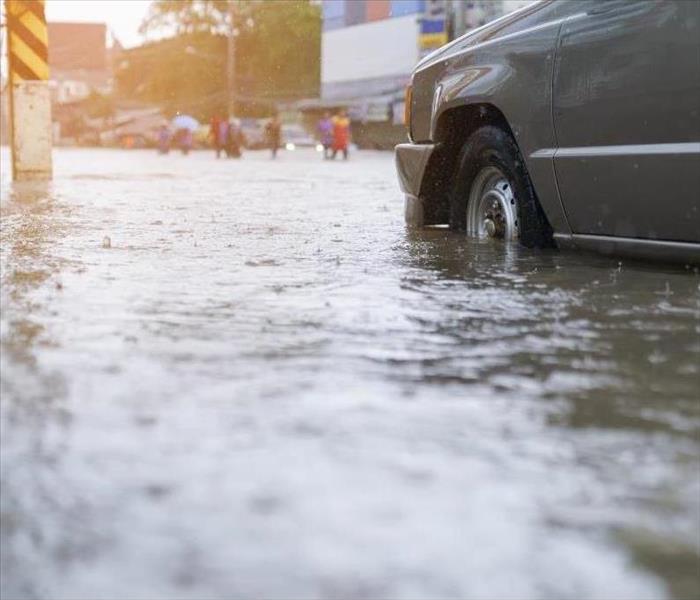 SERVPRO of St. Charles is here to help with flood damage
SERVPRO of St. Charles is here to help with flood damage
Floods can be devastating natural disasters, wreaking havoc on homes and properties. Recovering from flood damage requires a well-structured and organized approach to minimize further loss and restore your property to its pre-flood condition. In this article, we will provide you with a comprehensive guide on how to handle flood damage effectively. By following these steps, you can navigate the restoration process more efficiently and ensure the safety and well-being of your home and family.
Step 1: Ensure Safety
Before entering your home or property after a flood, prioritize safety. Ensure that the floodwaters have fully receded and it is safe to return. Be cautious of structural damage and potential electrical hazards. Wear appropriate protective gear such as rubber gloves, boots, and face masks to avoid exposure to contaminants in the water.
Step 2: Document the Damage
Once it is safe to enter your property, thoroughly document the flood damage. Take photographs or videos of all affected areas, including structural damage, personal belongings, and appliances. This documentation will be invaluable for insurance claims and aid in the restoration process.
Step 3: Contact Your Insurance Company
Notify your insurance company about the flood damage as soon as possible. Provide them with all necessary details, including the extent of the damage, photographs, and videos. Understand your insurance policy and coverage to ensure you are aware of what is eligible for compensation.
Step 4: Disconnect Utilities
For safety reasons, turn off the main power supply to your property. Additionally, shut off the gas and water supplies to prevent further damage and potential hazards. Contact the appropriate utility companies if you require assistance with these procedures.
Step 5: Remove Standing Water
Begin by removing any standing water from your property. Use pumps, wet/dry vacuums, or hire professional water extraction services if necessary. Properly dispose of the water to prevent contamination and further damage.
Step 6: Dry and Ventilate the Property
After removing the standing water, it is crucial to dry out your home or property thoroughly. Open windows and doors to promote air circulation, and use dehumidifiers, fans, and heaters to expedite the drying process. Remove wet carpets, furniture, and other items that can harbor moisture.
Step 7: Clean and Disinfect
Floodwaters can introduce harmful contaminants and pathogens to your home. Clean and disinfect all affected surfaces, including walls, floors, and furniture. Use appropriate cleaning agents, wear protective gear, and follow manufacturer instructions for effective disinfection.
Step 8: Remove Damaged Materials
Inspect your property for damaged materials that need to be removed. This may include drywall, insulation, flooring, and furniture. Discard damaged items properly, following local regulations, and keep a detailed inventory of all disposed of belongings for insurance purposes.
Step 9: Repair and Restore
With the damaged materials removed, assess the structural integrity of your property. Repair any structural damage, including walls, floors, and roofs, with the help of professionals if necessary. Ensure that repairs comply with building codes and regulations.
Step 10: Seek Professional Assistance
Depending on the severity of the flood damage, you may need to engage professional restoration services. Experienced flood damage restoration companies, like SERVPRO of St. Charles, can provide expertise and specialized equipment to expedite the restoration process and mitigate further damage.
Step 11: Evaluate and Enhance Future Protection
As you restore your property, take the opportunity to evaluate your flood protection measures. Consider implementing strategies such as installing flood barriers, elevating electrical systems, sealing foundation cracks, and landscaping changes to divert water away from your property. Consult with experts or local authorities for guidance on flood mitigation.
How to Know If Your St. Charles Home Has Plumbing Issues
3/7/2023 (Permalink)
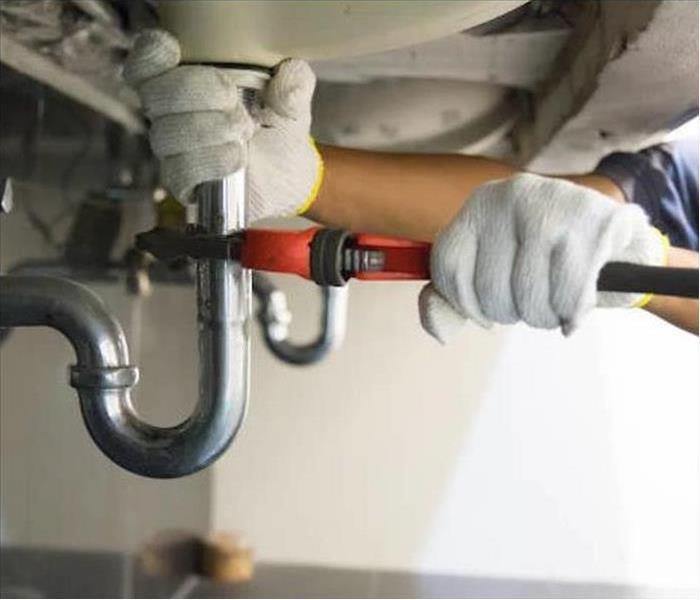 Plumber works on pipe in St. Charles, MO.
Plumber works on pipe in St. Charles, MO.
Water damage due to a plumbing issue in your St. Charles home can be life-changing. But there are some common signs that homeowners can look for, and steps they can take, to help avoid a major water issue at home.
Consider this example:
A homeowner and his family head off for a three-week vacation. While they’re away, a minor toilet leak grows, until it reaches a pace of three gallons of water per minute. By the time the homeowners returned from their three-week vacation, the unaddressed leak had poured more than 30,000 gallons of water into their home. The water ruined furniture, fixtures and irreplaceable family valuables, and rendered the property virtually uninhabitable for an extended period of time.
But this is just a cautionary tale. The following guidance is meant to help you learn about the potential water issues from common plumbing problems and how you can take steps to help prevent disaster.
Causes For Plumbing Problems
Plumbing issues can occur anywhere in your home. Frequently, lack of maintenance is the root cause of these problems. However, other causes can include:
- Manufacturing and design defects.
- Installation errors.
- Exposure to cleaning products (for example, by storing chemicals under the sink or by cleaning surfaces of plumbing components).
If caught early, many plumbing problems can be addressed before serious damage occurs. For this reason, regular inspection of your home’s visible plumbing parts can be critical. Knowing the lifespan of parts and appliances is also important, as is properly maintaining the other parts of your home and its features and systems.
Signs to Look For
Want to help prevent plumbing complications from damaging your home and potentially resulting in expensive property damage or loss? Start by visually inspecting your plumbing on a regular basis. Look for drips and slow leaks. Be sure to check the areas surrounding your pipes as well. If you see water damage on cabinetry or other nearby materials, there may be an active leak that you’ll want to locate.
Your entire home plumbing system may not be visible, but there are certain places in your home where you can readily inspect plumbing components:
- Under sinks and washtubs.
- Inside access panels near showers, sinks or appliances.
- Attachments to toilets, water heaters and appliances.
- Basements and crawl spaces.
You will want to look at any piping, valves and fittings in the areas listed above. Leaks are most common at connection points, so pay close attention to the plumbing connections on faucets, washing machines, refrigerators, dishwashers, water heaters, water filtration systems, shut-off valves and toilets. Your home’s piping system may also have multiple connections between various sections of pipe. Appliances and fixtures themselves can cause problems, so be sure to inspect those as well, and keep up with any regular maintenance recommended by the manufacturer.
The signs of a problem will vary by component. For example, problems in copper piping may look very different from problems in PEX, a common type of plastic piping. In general, you want to look for signs of corrosion, cracking, hazing, discoloration and mineral deposits from a water leak.
Protect Your St. Charles Home From Water Damage
2/24/2023 (Permalink)
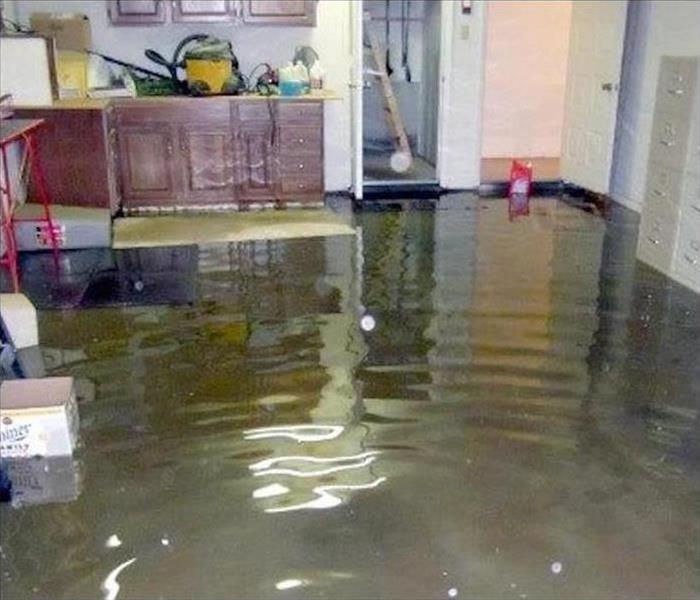 Prevent water damage in your St. Charles home.
Prevent water damage in your St. Charles home.
There are many ways to help protect your St. Charles home from water damages. Water losses occur when water finds its way outside of the appliances you rely on to run your household’s daily needs. When we think about the causes of severe water damage to our homes, we usually think about extreme weather like a hurricane or torrential rains. But the unfortunate reality is that extensive damage is often the result of ordinary household plumbing systems and appliances that fail – and these can be just as destructive to your home as an extreme weather event.
Preventative Measures
Fortunately, there are steps that you can take to help prevent water damage from plumbing problem in your St. Charles home. It is helpful to understand some of the common causes of water damage.
These may include:
• Heating and air-conditioning systems
• Water heaters
• Valves
• Appliances
• Pipes and plumbing fixtures
How to Detect Water Damages
Water damage can often go undetected, even if the telltale signs are there. Plumbing that is housed inside the walls of your home, in less-trafficked areas like a basement or attic, or behind a cabinet or appliance, can easily go unnoticed. That’s why it’s important to check your appliances and plumbing from time to time.
- Know where the main water supply enters your home, locate the main shut-off valve and make sure it’s functioning properly.
- If you will be away from home for an extended period, consider shutting off the water supply, but consult with a heating professional first to understand if doing so will compromise any other systems in your home. Maintain a temperature of at least 55 degrees in your home. Also, if your home is protected by a fire sprinkler system, do not turn off the water to this system, and maintain sufficient heat to prevent a freeze-up.
- Consider having your air-conditioning system inspected regularly by a professional. Check around the unit for indications of leaks. Check the drain lines annually and clean them if they are clogged. Change the air filter annually at a minimum.
- Inspect water heaters, showers, tubs, toilets, sinks, dishwashers, refrigerators and washing machines annually, and have them repaired if there are signs of leaks or corrosion. Be sure to include supply lines, hoses, connections and fittings in the inspection.
- Check caulking around showers, bathtubs, sinks and toilet bases, and make repairs as needed.
- If your refrigerator has an ice machine or water dispenser, check the hose between the wall and the refrigerator to determine if it is pinched or stressed. Also look for signs of leaking or wear and tear.
- Check exposed plumbing (pipes, valves, etc.) for signs of leaking or corrosion. Have any pipe damage fixed immediately to prevent more costly repairs in the future.
For any questions or concerns about water damage in your home, call SERVPRO of St. Charles at (636) 442-0847
Water damage due to a plumbing issue in your home can be life-changing. But there are some common signs that homeowners can look for, and steps they can take, to help avoid a major water issue at home.
Consider this example:
A homeowner and his family head off for a three-week vacation. While they’re away, a minor toilet leak grows, until it reaches a pace of three gallons of water per minute. By the time the homeowners returned from their three-week vacation, the unaddressed leak had poured more than 30,000 gallons of water into their home. The water ruined furniture, fixtures and irreplaceable family valuables, and rendered the property virtually uninhabitable for an extended period of time.
But this is just a cautionary tale. The following guidance is meant to help you learn about the potential water issues from common plumbing problems and how you can take steps to help prevent disaster.
Causes For Plumbing Problems
Plumbing issues can occur anywhere in your home. Frequently, lack of maintenance is the root cause of these problems. However, other causes can include:
- Manufacturing and design defects.
- Installation errors.
- Exposure to cleaning products (for example, by storing chemicals under the sink or by cleaning surfaces of plumbing components).
If caught early, many plumbing problems can be addressed before serious damage occurs. For this reason, regular inspection of your home’s visible plumbing parts can be critical. Knowing the lifespan of parts and appliances is also important, as is properly maintaining the other parts of your home and its features and systems.
Signs to Look For
Want to help prevent plumbing complications from damaging your home and potentially resulting in expensive property damage or loss? Start by visually inspecting your plumbing on a regular basis. Look for drips and slow leaks. Be sure to check the areas surrounding your pipes as well. If you see water damage on cabinetry or other nearby materials, there may be an active leak that you’ll want to locate.
Your entire home plumbing system may not be visible, but there are certain places in your home where you can readily inspect plumbing components:
- Under sinks and washtubs.
- Inside access panels near showers, sinks or appliances.
- Attachments to toilets, water heaters and appliances.
- Basements and crawl spaces.
You will want to look at any piping, valves and fittings in the areas listed above. Leaks are most common at connection points, so pay close attention to the plumbing connections on faucets, washing machines, refrigerators, dishwashers, water heaters, water filtration systems, shut-off valves and toilets. Your home’s piping system may also have multiple connections between various sections of pipe. Appliances and fixtures themselves can cause problems, so be sure to inspect those as well, and keep up with any regular maintenance recommended by the manufacturer.
The signs of a problem will vary by component. For example, problems in copper piping may look very different from problems in PEX, a common type of plastic piping. In general, you want to look for signs of corrosion, cracking, hazing, discoloration and mineral deposits from a water leak.
For any questions or concerns about water damage in your home, call SERVPRO of St. Charles at (636) 926-0033.
Why You Should Check Your Sump Pump At Least Once Per Year
2/21/2023 (Permalink)
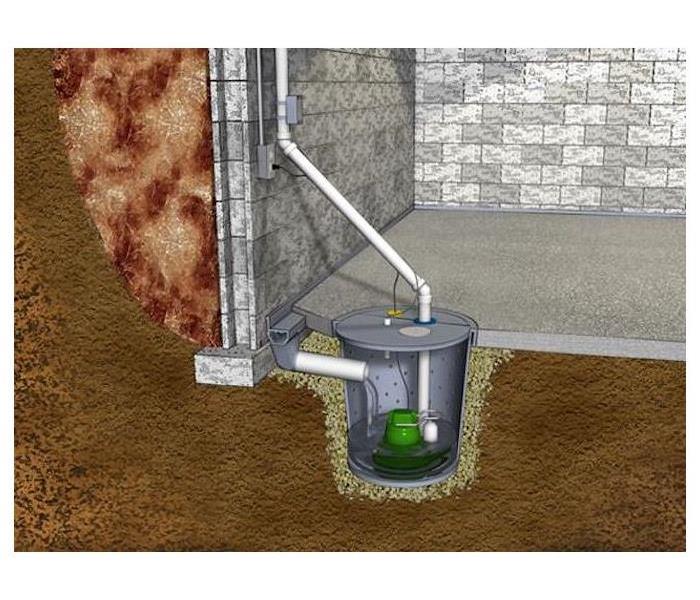 Inspect your sump pump at least once a month.
Inspect your sump pump at least once a month.
A sump pump is a vital component of your home's equipment.
Sump pumps help keep your property safe by controlling water and keeping your home dry. Often found in basements, sump pumps are typically professionally installed in a specially constructed sump pit. When the water table around your home is high, your sump pump can help keep your basement dry and can minimize damage to your home if you experience a plumbing or appliance leak. As a homeowner, you'll want to maintain your sump pump to make sure it's working properly.
The sump pump's job is to pump water outside and away from the home. To help keep it functioning properly, your sump pump needs regular maintenance. Here are some tips to help make sure your sump pump stays in good working condition.
How to Help Keep Your Sump Pump in Good Condition
- Check the pump at least once a year:
• Is the sump pump plugged in?
• Is the power cord in good shape?
• Is the discharge hose connected properly?
• Is there any debris in the area that could clog the pump and prevent it from working properly?
To check if your sump pump is functioning properly, pour water into the sump pit. Look for the sump pump to start up automatically and whether the water drains quickly.
- Since sump pumps run on electricity, consider installing a battery backup to help ensure yours will not fail, even in the event of a power outage. If you have installed a battery backup, during your test of the sump pump installation, unplug the pump to ensure that it will function properly on battery power.
- Find the location where your pump discharges outside your home. Make sure that the discharge will not occur near your foundation, and that the area is clear of any debris. Do not discharge your sump pump into a septic tank or sewer system. Contact a licensed professional if you need help locating where your sump pump discharges.
- Promptly contact a licensed professional if your sump pump is not working properly.
Water Damage Prevention Tips
11/17/2022 (Permalink)
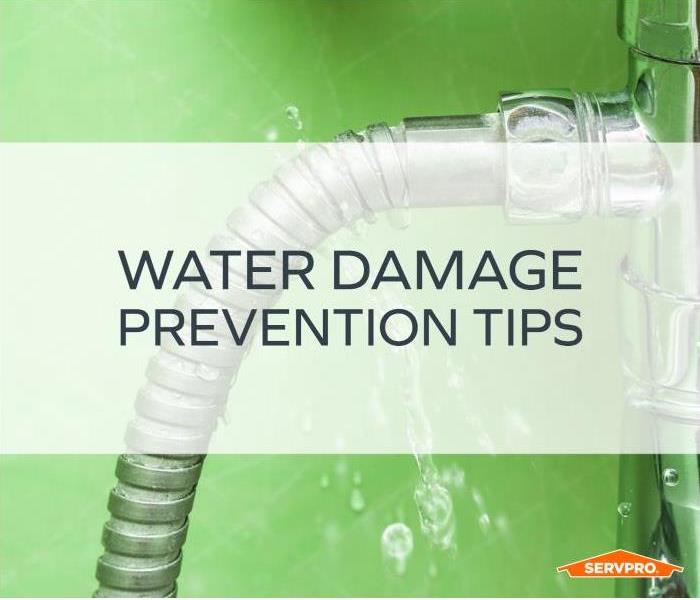 Don't wait. If you have water damage, contact SERVPRO of St. Charles.
Don't wait. If you have water damage, contact SERVPRO of St. Charles.
Ignoring water damage in your home can be a costly mistake. Knowing what to do to avoid water damage can protect your investment.
Here are a few ways you can avoid water damage in your St. Charles, Missouri home:
- Older wood windows should be cleaned, repainted, and re-stained periodically. Glazing compound around older windows should be replaced as needed. Update your windows and doors. Watertight options are best in new windows and doors.
- Replace washing machine supply hoses. Plan for new ones every three to five years as part of a proactive maintenance plan.
- Regularly check your roof for signs of damage, such as excessive wear on shingles or missing shingles.
- Use gutters and downspouts to make sure water is diverted away from your home and its foundation. In some cases, it is necessary to update of repair drainage.
- Test your sump pump twice a year or as suggested by the manufacturer.
- Much home piping has a lifespan of 50 to 80 years, so if you have an older house, ask a plumber to check its condition. PVC pipes may need to be replaced every 25 to 40 years.
- Seal your basement. Thick coatings, paint and silicate-based sealers may help minimize or prevent water damage. Each method varies in application and cost.
Even minor plumbing problems can turn into major issues down the road. Mold and mildew can create the ideal conditions for harmful bacteria and fungus to start growing and eventually cause a myriad of health problems for your family, including young children and family pets.
If left unchecked, water leaks will cause more damage to your home or business, which is why they need to be addressed the instant you notice them.
Water Damage? Contact SERVPRO of St. Charles at (636) 926-0033.
Mold Remediation in St. Charles After Major Flash Flooding
8/18/2022 (Permalink)
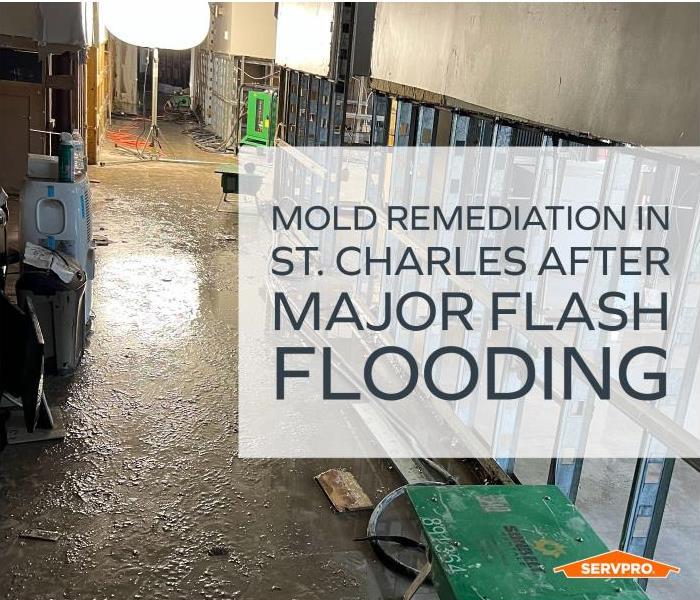 If your St. Charles, MO home or business has mold damage from the recent flash flooding or another source, we are here to help.
If your St. Charles, MO home or business has mold damage from the recent flash flooding or another source, we are here to help.
After the significant rainfall that occurred just a few weeks ago there may start to be a musty odor in your home or business. Maybe you can see mold spores starting to grow on your drywall in a dark corner of your basement. SERVPRO of St. Charles can help you remove the mold and musty odor that has invaded your property. We specialize in water and mold restoration, with advanced training in restoration techniques and experience to quickly restore your property.
How can I tell if I need mold remediation?
Unfortunately, if your home or business was impacted by flash flooding or interior water damage, mold is a likely outcome if it was not dried properly. Mold spores will thrive when given moisture and the right materials to feed on. While mold is present everywhere, indoors, and outdoors, we can restore your home or business to pre-exposure levels.
When you call SERVPRO of St. Charles, our Green Fleet to your door with skilled technicians and all the right equipment for the job. Every mold infestation is different, from the amount of mold to the types of materials affected. Each scenario requires a unique solution, but the general process stays the same. After our arrival, we will:
- Identify the moisture source to remove water and address the root cause. Failing to do so only means we leave an outlet for mold to develop again.
- Containment is put into place using sheeting and negative air pressure to keep microscopic spores from moving into unaffected areas of your property.
- We begin pulling up mold spores with the help of vacuums and air scrubbers with HEPA filtration.
- All surfaces get thoroughly cleaned, sanitized, and deodorized with the help of specialized cleaning agents and anti-microbial products.
We welcome questions and want you to feel comfortable while our technicians are repairing your property. If you want a new level of peace of mind when hiring someone for mold remediation, our skilled team at SERVPRO of St. Charles is here to help.
If You See Signs of Mold, Call Us Today – (636) 926-0033
Sump Pump Checklist
4/5/2022 (Permalink)
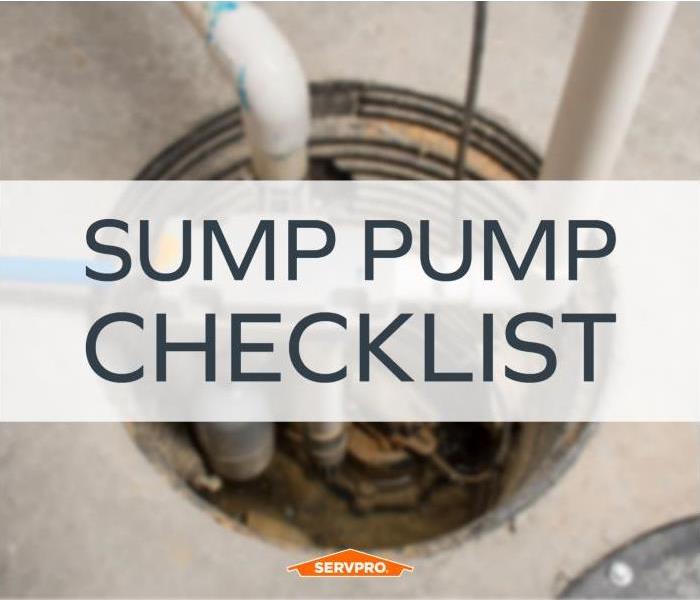 At SERVPRO of St. Charles, we are ready to help restore water damage from a malfunctioning sump pump, or any other source, without delay.
At SERVPRO of St. Charles, we are ready to help restore water damage from a malfunctioning sump pump, or any other source, without delay.
If your basement is usually dry during the rainy season, thank a sump pump. It works hard to keep it that way by automatically pumping out water that's threatening to enter it.
It's important to periodically check your sump pump to make sure it's working properly. Doing this will help keep the water out of your basement and prevent it from causing damage.
It's also important to know how to check and maintain your sump pump. Below are a few tips to keep your sump pump running and prevent accidental breakdowns.
- Make sure that the pump is completely upright. Doing so will prevent it from tipping over and putting too much pressure on its components.
- Take the cover off the pump and look inside. Make sure that the basin and pit are clear of debris and any other objects that might cause an overflow.
- Make sure that the drain hose is connected correctly. A blocked drain hose can cause your pump to run continuously, which could affect its ability to dispose of the water that's collected in the pit.
- If the inlet screen is blocked, the water that's coming from the pump will not be able to enter the pit. This could cause a basement flood.
- Make sure that the float component of your sump pump is free of debris and is moving freely. A faulty float can cause the pump to run continuously, which could eventually cause its engine to fail.
- The next time you hear your sump pump running, go outside and make sure its discharge pipe is pumping the water away from your home at a safe distance. If it’s too close, the water could seep back into your pump, causing your pump to run continuously and inefficiently. The more your sump pump runs, the more likely it is to burn out early in its life span.
- To test the performance of your sump pump, fill the pit with water and turn it on. After carefully monitoring the situation, make sure that the discharge pipe is flowing properly.
- Having a backup battery or a generator is also important if the power goes out during a storm. This could cause your pump to stop working, which could cause a flood in your basement.
If you perform all these steps and notice an issue, it may be time to call a professional to diagnose and fix the issue with your sump pump. Don’t risk damage and get it fixed quickly.
While these tips may help prevent your sump pump from breaking, there is always the unexpected issue that may occur. At SERVPRO of St. Charles, we are ready to help restore water damage from a malfunctioning sump pump, or any other source, without delay. Serving the greater St. Charles, Missouri area, we strive to arrive onsite quickly and restore your home to preloss condition.
Will Insurance Cover My Water Loss?
2/22/2022 (Permalink)
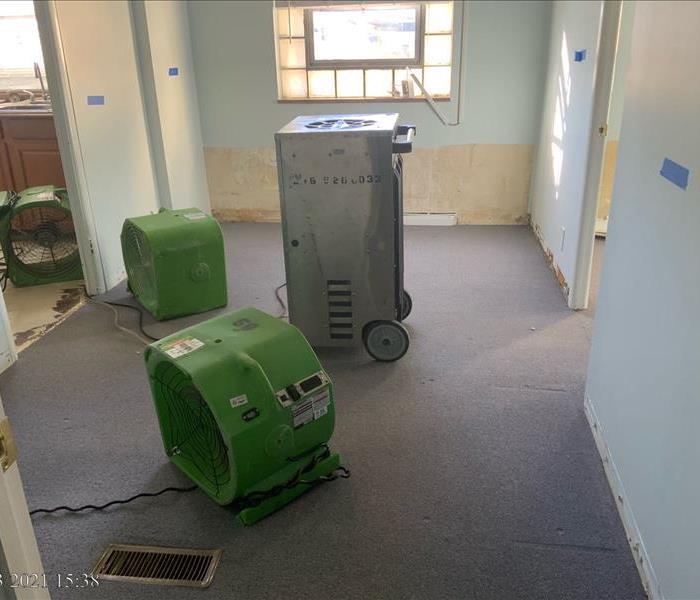 We respond to large and small water damage intrusions 24 hours a day, 7 days a week, 365 days a year throughout the greater St. Charles area.
We respond to large and small water damage intrusions 24 hours a day, 7 days a week, 365 days a year throughout the greater St. Charles area.
Water can be one of the biggest threats to your home and belongings and having insurance that covers water damage is critical. Water damage is one of the most common and costly types of insurance claims. According to the Insurance Information Institute, 29% of all homeowner’s insurance claims are from water damage.
How well do you know your homeowner’s insurance? Did you know, typically water damage that is considered “sudden and accidental” is covered. However, gradual damage can get a bit trickier. Frequently, flooding is not covered unless you have a separate flood insurance policy.
What else usually isn’t covered? Here are some common problems that are typically not covered by a standard homeowners insurance policy.
- Water damage due to lack of maintenance. An example would be failing to fix a known plumbing issue.
- Water damage from intentional acts. This includes setting your house on fire or purposely turning off the heat during the winter.
- Water damage due to floods, hurricanes, and tsunamis. While we may not need to worry about hurricanes or tsunamis in Missouri, flooding can often cause problems for homeowners.
- Water damage that backs up through a sewer, drain, or sump pump. This typically requires special sump and water backup coverage.
- Water damage from leaks from a swimming pool or other structures.
- Water damage from seepage or leaks through a foundation.
- Cost to repair or replace the source, such as a broken dishwasher or washing machine.
While these are the most common problems, the most reliable way to know what isn’t covered is to talk to your insurance agent. Depending on the type of water damage and size, it can often cost thousands of dollars to repair water damage. Knowing your coverage can help you know what to expect.
Who do you call for water damage restoration?
When your home suffers a water damage, call a professional. As leaders in the water damage industry, SERVPRO of St. Charles City has advanced training and expertise, not to mention a tremendous amount of hands-on experience. We use this training and experience to quickly dry your home and restore it back to pre-water-damage condition. Our process includes documentation of the drying process to validate your property is dry. For a stress-free claims process, SERVPRO works with your insurance to help manage the insurance process and paperwork.
We respond to large and small water damage intrusions 24 hours a day, 7 days a week, 365 days a year throughout the greater St. Charles area, including St. Peters, O’Fallon, Weldon Spring, and Portage Des Sioux.
We are here to help: (636) 926-0033
Frozen and Burst Pipe Prevention Explained
1/18/2022 (Permalink)
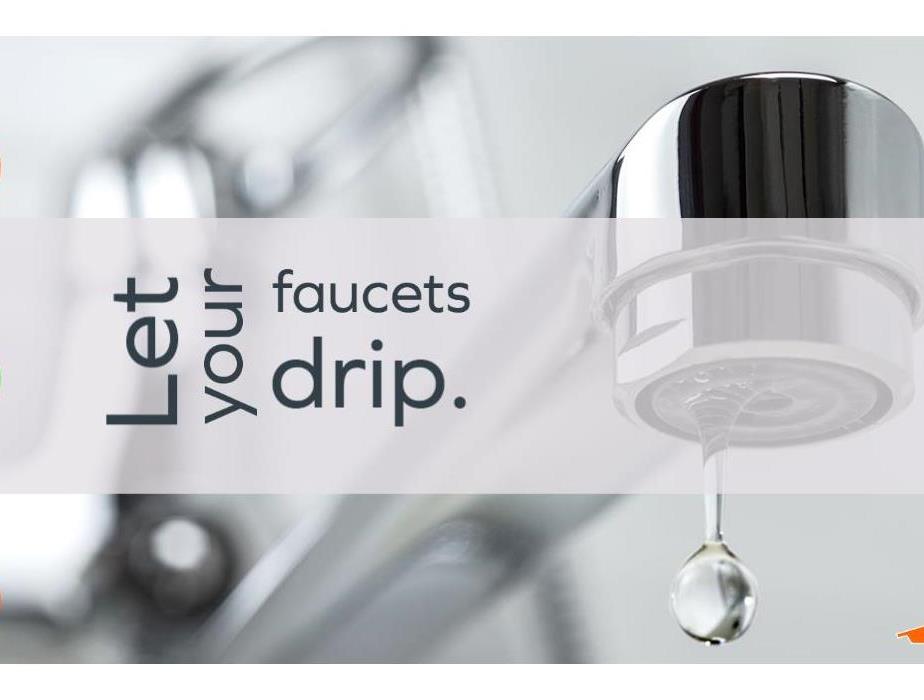 Letting your faucets drip can be a helpful prevention method for frozen pipes.
Letting your faucets drip can be a helpful prevention method for frozen pipes.
Each winter, we at SERVPRO of St. Charles city see frozen or burst pipes wreak havoc on our commercial and residential customers. What can you do to help prevent damage? What can you do to minimize or restore damage if it does occur?
How to Avoid Frozen Pipes
Prevention is a key step when it comes to frozen pipes.
These inexpensive measures might help you avoid professional water damage restoration. Try these ideas:
- Regularly check pipes for damage. As pipes age, even metal ones degrade and crack.
- Insulate pipes to heat evenly. Stable temperatures make the pipes less vulnerable to changes in the weather that may cause them to expand or contract.
- Seal gaps where cold air enters. Even a small opening lets in enough air to significantly lower the temperature of a room.
- Insulate attics and basement spaces. If water pipes are running through these areas, insulation will prevent residential and commercial water damage from ruining a cozy home or office building.
When you hear the weather report that temperatures are dropping, the following tips can help:
- Keep the thermostat above 55 degrees, even in unused rooms.
- Let warm kitchen air into cabinets by opening doors that can warm the pipes behind them.
- Open faucets to keep the water slowly circulating through the pipes so that it doesn’t freeze.
- Turn off the water at the mains before going on vacation.
What to Do When Your Pipes Freeze
Even after precautions, pipes still freeze. However, there are a few things to make pipes less likely to burst.
- If pipes freeze, turn the water off at the main connection.
- Open working faucets and leave the water running.
- Open the faucet closest to the frozen pipe and start thawing the ice slowly. For example, lie a heat pack on the part of the pipe closest to the faucet, slowly moving it along the frozen pipe as the ice melts.
What to Do When a Frozen Pipe Bursts
- Shut the water supply. It is a great idea to know where the valve is to the main water supply on the property before an emergency. Turn it off as soon as the leak or freeze issue becomes apparent.
- Mop if it’s safe. Water causes nasty problems, and it might be helpful to assist in preliminary water removal with a bucket or mop while waiting for professional water cleanup. Only do this if it is safe—there should be no electricity or saltwater damages when walking or touch spills. If there’s uncertainty, wait for the water or fire damage restoration service to arrive and keep people away from the area.
- If there is damage, call SERVPRO immediately—prompt repairs will prevent other issues from arising at the height of the cold weather. Water damage is our specialty, and if water damage is done incorrectly, it could mean mold remediation later.
If your home or business has water damage from a burst pipe or another source, give SERVPRO of St. Charles City a call.
The phrase “Faster to Any Size Disaster” is a SERVPRO motto and it describes the culture of SERVPRO of St. Charles City. We respond to large and small water damage intrusions 24 hours a day, 7 days a week, 365 days a year throughout the greater St. Charles area, including St. Peters, O’Fallon, Weldon Spring, and Portage Des Sioux.
Will a Drain Cleaner Damage My Pipes?
12/26/2021 (Permalink)
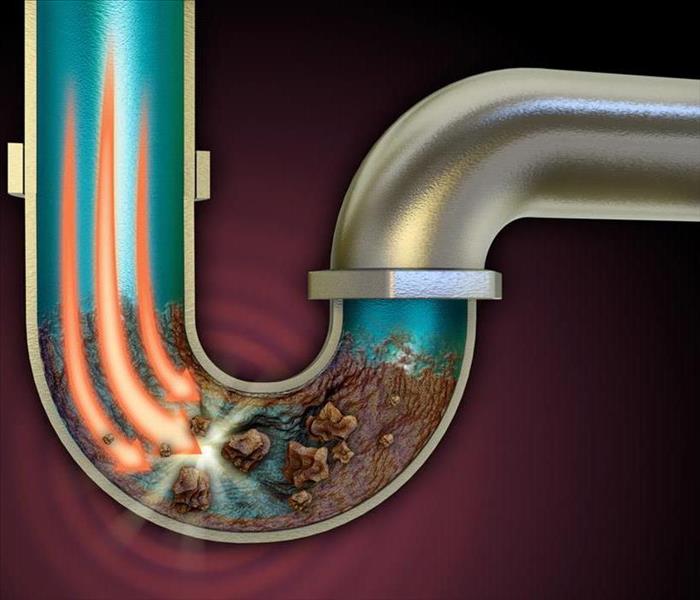 Make sure your drains stay clear for a good, long time.
Make sure your drains stay clear for a good, long time.
Can Cleaning Products Damage Your Pipes?
As a homeowner in Weldon Spring, MO, you most likely will encounter a clogged drain at some time. Your first inclination might be to go to the store and pick up some drain cleaner. This may seem like a simple solution, but can cleaning products damage your pipes?
How They Work
There are three different kinds of chemical cleaners:
- Oxidizing - includes peroxides, bleach or nitrates
- Acid - muriatic acid or sulfuric acid
- Caustic - caustic potash or lye
These cleaners use an electron transfer process to either give or take away electrons from the organic substances blocking the pipe, thereby creating heat, which breaks down the materials and clears the clog. This process can, however, cause harm to your pipes.
How They Cause Harm
The heat from these chemicals can warp or soften the pipes, especially when they are older metal pipes or plastic pipes. There's a higher danger of damage if the clogged drain is completely blocked. If there's nowhere for these caustic chemicals to go, they will just sit in the pipes, eventually eating through them if not removed.
Besides harming your pipes, these chemicals can be harmful to you and to the environment. They can irritate your throat and eyes, and if improperly handled, can cause burns. Once they go down the drain, they can end up in waterways and landfills, causing harm to wildlife.
Alternatives
Before using a chemical in the drain, try to clear the blockage using a snake or augur. If this doesn't do the trick, try using a non-toxic solution such as an enzymatic drain cleaner. These cleaners work by actually eating the clog with bacteria or enzymes. They work best on organic blockages such as soap or hair but can take as long as 24 hours to work.
If you are not able to clear the clog by yourself, it's best to call a plumbing professional to assess the problem and clear the clogged drain. If the blockage is further down the pipes, they can do a thorough sewage cleaning to make sure your drains stay clear for a good, long time.
Planning for Water Damage Cleanup
11/1/2021 (Permalink)
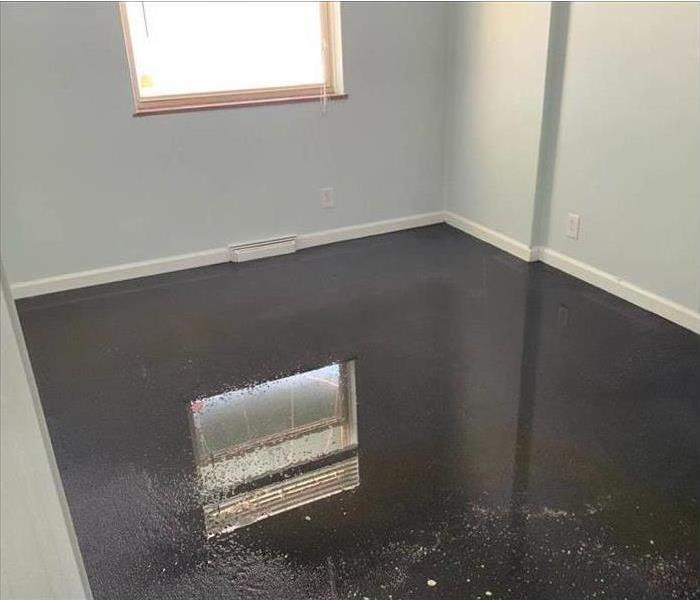 Water damage in a Portage Des Sioux, MO home.
Water damage in a Portage Des Sioux, MO home.
It is tremendously difficult to overstate the damage water can cause to a home. Because water is liquid, it can seep into places you may not even notice. Even worse, bursting pipes can flood a basement or other area quickly. If your Portage Des Sioux, MO, home has sustained water damage, you may be wondering how long restoration and remediation will take.
The Drying Process
Once you fix a broken pipe, your restoration service will likely begin to dry out your house. In most cases, drying a home takes between two and three days. There are, of course, special circumstances that may lengthen drying time. These can include the following:
- You have soaked wood floors
- You live in a humid climate
- Your home has sustained damage to several areas
Wood floors typically take between seven and 10 days to dry out completely. Restoration technicians usually use large fans to circulate air in the affected areas. Of course, if there are high levels of humidity in your house, drying times can take longer. Since bursting pipes can distribute water over large sections of your home, removing the excess water may extend the drying process as well.
The Restoration Process
When you work with a Portage Des Sioux, MO, restoration service, you can benefit from both expertise and equipment. Chances are good you can neither buy nor rent enough professional grade fans to sufficiently dry out your house. Because restoration technicians understand how to restore the comfort, value and appearance of your home, they are better able to target their efforts to maximize impact.
Few things can destroy a home faster than water damage. Still, you don’t have to be afraid of bursting pipes. When you notice flooding or other water-related damage, you can stop the event from continuing. Then, you may choose to work diligently to mitigate the negative effects of the damage. With the right professionals on your side, you can boost your odds of restoring your home to its pre-flood condition.
3 Reasons To Purchase Business Insurance
8/31/2021 (Permalink)
 Water damage can be devastating to your business, and without insurance, making repairs can be expensive and time-consuming.
Water damage can be devastating to your business, and without insurance, making repairs can be expensive and time-consuming.
Managing a business in St. Charles can be a rewarding endeavor, allowing you to connect with your community and to share your passions with others. Unfortunately, water damage can be a huge setback to businesses of all types. Business insurance can help protect your company in the event that your commercial property is damaged by water.
Financial Security
With all the time, money, and energy it takes to maintain a successful business, liquid damage can create a mess that is costly to repair. Since the damage can happen so quickly, it’s often not possible to protect important documents, products, or other valuable items. Recovering and replacing expensive tools and products without insurance can be incredibly expensive. Business insurance often covers the costs of damage caused by floods, burst pipes, and other events that result in water damage.
Quick Cleanup
Water can quickly puddle and can result in a tremendous amount of damage to a business. Without insurance, you may spend unnecessary time trying to clean your space to prepare for repairs, and damage from water can even create hazardous environments. However, business insurance ensures that water cleanup is quick, easy, and efficient. With your business clean and safe, you’ll be able to reopen your location as soon as possible.
Peace of Mind
Maintaining a business means spending hours every day making sure you give your consumers the best products or experiences, and additional stress can take time away from perfecting your company. Although taking preventative measures to keep your location protected is always a good idea, water destruction cannot always be prevented. Not knowing how to respond if your business is damaged by water can create more stress, but business insurance can give you confidence that your organization can recover if water damages it.
Water damage can be devastating to your business, and without insurance, making repairs can be expensive and time-consuming. Business insurance can ensure that your business is protected in case your property is damaged by water.
How To Identify Category 3 Water Damage
7/13/2021 (Permalink)
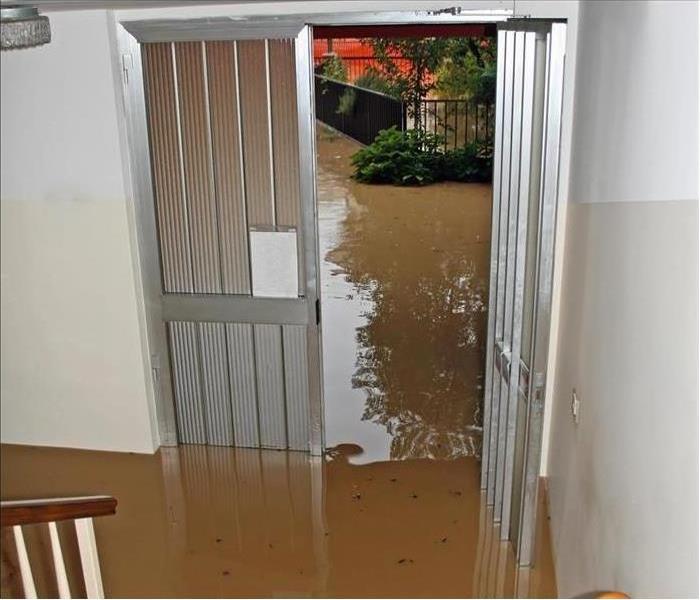 Flooding caused by rain in O' Fallon, MO
Flooding caused by rain in O' Fallon, MO
Learn How To Identify Black Water and Clean Up This Type of Damage
Category 3 water is highly contaminated. Insurance companies and restoration experts use this categorization to describe water that may contain chemicals, pathogens, and solid waste. This category of water calls for sewage cleanup. Identify the Source
The third category of water damage differs from the first two categories in terms of its origin. Category 1 water is clean, treated, and comes from a supply pipe. Category 2 water is contaminated, but does not contain solid waste. Category 3 water is a result of:
- Flooding caused by rain or rising bodies of water
- Sewer backups
- Water left standing for long periods of time
If water in a residence comes from any of these sources, it is very likely contaminated. Cleanup methods will depend on the amount of solids present.
Determine the Consistency
The fastest way to eliminate standing water is to use a pump. Some pumps can extract solid waste in addition to water. Homeowners will probably need to rent a pump or hire a water damage cleanup company. Solids in this category of water may include:
It is necessary to remove all standing water and solids. Homeowners or cleanup professionals should wear personal protective equipment when dealing with contaminated water.
Clean and Disinfect
In addition to cleaning, it is also necessary to disinfect areas exposed to black water. Mitigation professionals often perform several phases of cleanup, including:
- A disinfecting pre-treatment
- Tearing out
- Cleaning
- Disinfecting
Carpet and drywall should be torn out and replaced, as it is difficult to completely disinfect porous materials. Professionals can recommend the best approach to clean and restoration.
Homeowners should hire a sewage cleanup company to remove black water from a residence in O'Fallon, MO. Quickly completing the mitigation process may limit primary damage and reduce the risk of mold.
How To Prevent Water Damage in Your Home
3/12/2021 (Permalink)
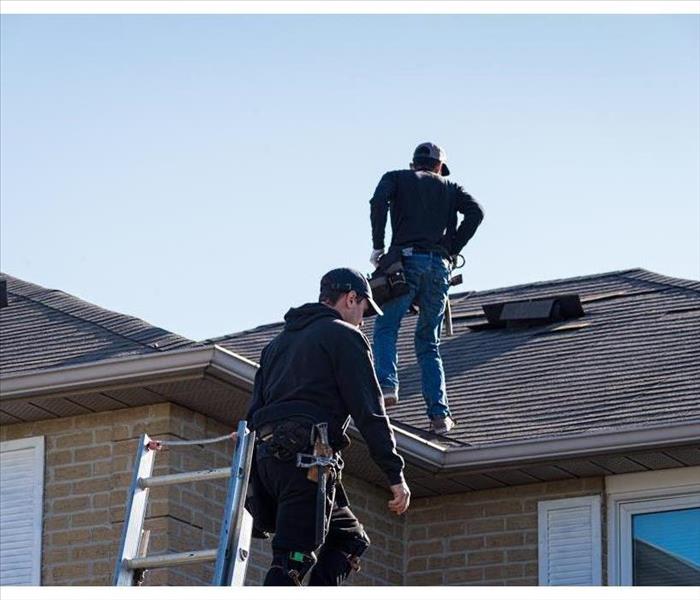 Roof inspection in a St. Charles, MO.
Roof inspection in a St. Charles, MO.
Common Locations For Water Damage
Water in a home is a devastating condition. Burst pipe cleanup, in particular, can require extensive restoration. Yet, even small leaks can cause thousands of dollars in damage to your St. Charles, MO, house. Luckily, you can prevent many water losses by performing basic inspections of your plumbing system. Here are some common locations for water damage and how you can keep them dry.
1. Water Heater
Most water heaters last 10 to 15 years. If your heater is older than that, you should replace it before it breaks down. You should also keep the heater in a basement or garage. This way, if it does leak, it will not cause as much damage. Since even a tiny amount of water in a home can be harmful, you should check the heater frequently.
2. Ceiling and Roof
Similarly, the roof of your property should be inspected for holes or other potential issues. Usually, by the time you notice a puddle of water on the ceiling, the liquid has already caused a ton of damage. A licensed professional should know how to spot leaks before they become visible.
3. Pipes
Many water problems are caused by a broken pipe. This often takes place during the winter months when pipes are known to burst. Keep your pipes as warm as possible. You can even purchase leak detection systems that will shut off your plumbing system if a malfunction occurs.
4. Air Conditioners
While air conditioners are incredible inventions, they are prone to water leaks. The drip pan, in particular, can overflow. Maintenance checks are thus a must. You should schedule them for the spring to ensure the system is working properly during the high-usage summer months. Leak detectors can help here, as well, especially for air conditioners in tough-to-reach locations.
Water in homes is a largely preventable problem. By performing proper maintenance and hiring professionals to conduct inspections, you can protect your beloved house.
Do You Have This Certain Type of Pipe? You May Be in for Unnecessary Sewer Cleanup
2/23/2021 (Permalink)
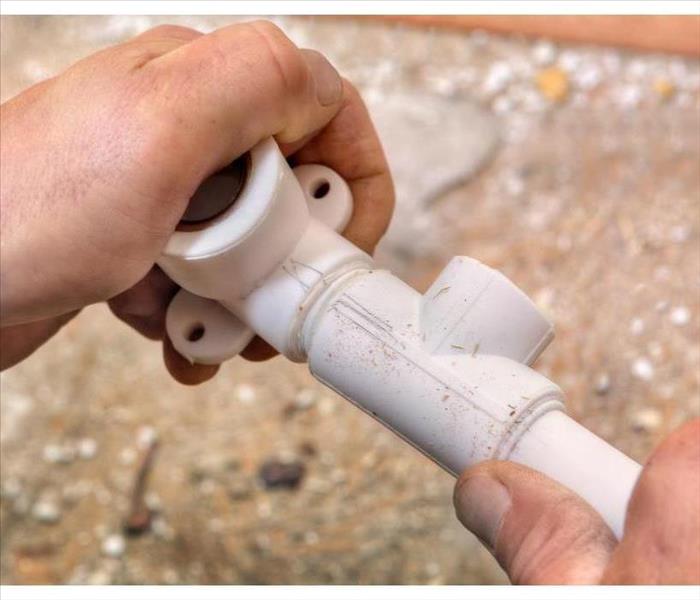 Do you have polybutylene pipes?
Do you have polybutylene pipes?
If the pipes in your commercial building were manufactured between 1978 and 1995, you may be in for some imminent sewer cleanup. Polybutylene pipes were used during that time period in place of copper pipes. They were less costly and easier to install. What's not to love? Well, there's a reason manufacture stopped in 1995. However, PB pipes are still commonly found in sewer systems that may lead right into your place of business.
Do You Have Polybutylene Pipes?
There are a few problems with this particular type of pipe:
- They are chemically reactive, breaking down when exposed to common cleaning agents.
- PB pipes can become brittle and crack over time.
- This can lead to leaks, backing up the sewers.
- These pipes are sometimes uninsurable.
To determine if you have PB pipes, you need to do a little digging. Leave the physical excavating to the experts, but if you can find a pipe coming out of the ground near your building's water heater, sink, or toilet, you can check for classic signs of a PB pipe. It will most likely be blue, black, or gray and one-half to 1 inch in diameter. These are good indicators that you have PB pipes in your sewer system.
However, there may be visible copper pipes and poly pipes hiding underground, closer to the water meter. If you don't want to go full-on detective mode on your pipes, it's OK to contact a sewer expert. Especially if there are any signs of sewer backup, such as a flooded toilet, it's advised to contact these professionals as soon as possible.
How Can You Prepare for Sewer Cleanup?
Preventing water damage from sewer backup issues starts with finding the right insurance coverage. It's harder, but not impossible, to cover PB pipes. Once you find adequate coverage, you will need to find trusted, insurance-preferred remediation experts in Portage Des Sioux, MO, to have on deck if and when disaster strikes. Even if you have this type of pipe, having a restoration plan makes for easier, cheaper sewer cleanup.
Steps To Follow When Fixing a Leaky Compression Faucet
1/3/2021 (Permalink)
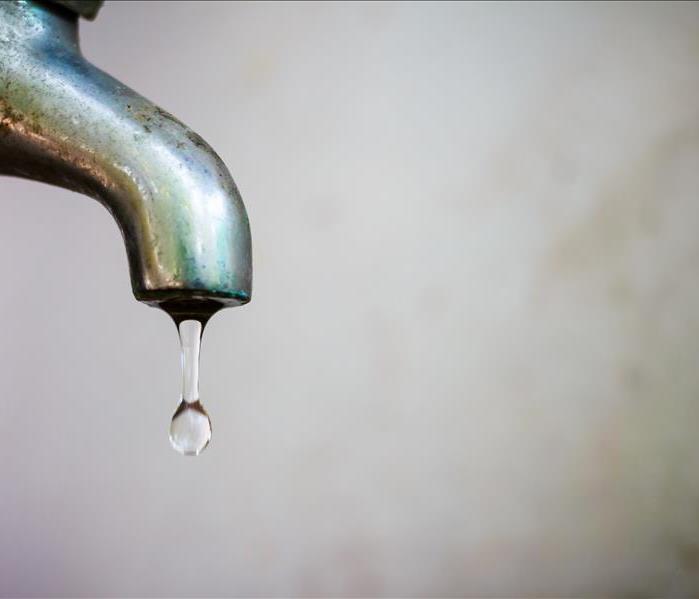 A leaking faucet is easy to fix if you follow these simple steps
A leaking faucet is easy to fix if you follow these simple steps
A leaking faucet usually indicates that an internal part has worn out. The most common type of faucet is the compression faucet, which has two handles that are screwed into place. One handle is for cold water, the other for hot water.
Let's Take a Look At the Steps Involved In Fixing a Leaky Compression Faucet
1. Shut the Water Off
The pipes underneath your sink will have shut-off handles. Twist them clockwise to shut the water off.
2. Cover the Drain
If you have a sink plug, push it down to plug the sink. If you don't have one, cover the opening with a towel or clean rag. This will prevent any washers or screws from falling into the drain.
3. Remove the Handles and Nuts
Unscrew each handle of the leaking faucet, and pull straight up to remove. Using a wrench, remove both nuts.
4. Lift The Stem Out
The stem is visible once you remove the handles and nuts. Remove that and you will see the O-ring and seat washer.
5. Replace the Seat Washer or O-Ring
Seat washer - Typically made of rubber, a worn washer is the most likely reason for a dripping faucet. Unscrew the brass screw to release it.
O-ring - If the leak is coming from one of the handles rather than the faucet, the O-ring needs to be replaced.
Since washers and O-rings vary in size, it's a good idea to bring the old one along when you visit the hardware store. You should also grease the replacement parts with plumber's grease before attaching them.
6. Reconnect the Handles
After reassembling all the components, reconnect the handles. Hopefully, you will have a fixed leak. If not, it's time to call a plumber in St. Peters, MO. If you discover water damage, you should call a water damage repair service right away.
A leaking faucet is easy to fix if you follow these simple steps.
Three Places to Find Water Supply Lines
12/28/2020 (Permalink)
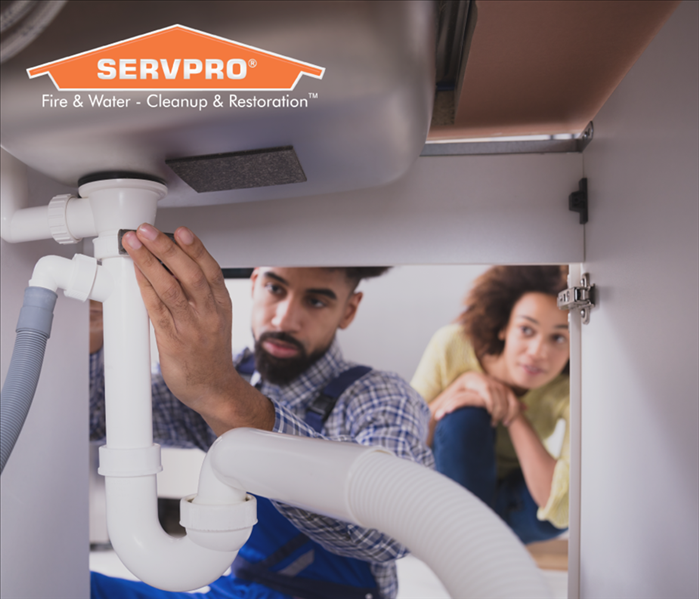 Regularly check under sinks for water buildup
Regularly check under sinks for water buildup
Three Places to Find Water Supply Lines
Water supply line damage can cause the construction materials of your home to become swollen, humid, and covered in mold. Supply lines are metal or plastic pipes that provide water to the plumbing fixtures in your home. These pipes become corroded with time and develop leaks. The common types of supply lines in St. Peters, MO, include:
- Copper
- Braided stainless steel
- Plastic
Plastic supply lines include a 5-8 year warranty and metal supply lines come with a lifetime warranty. Before purchasing a new supply line, check to see if your warranty will cover a replacement. Supply lines should be fixed immediately to prevent water damage to your home. Here are three places to find water supply lines:
The Kitchen Sink and Dishwasher
The supply line providing water to your kitchen sink and dishwasher can become corroded due to frequent use. If you find swelling wood in the cabinets underneath your sink, you likely have a damaged supply line. Replace this right away to avoid having to purchase new cabinets.
The Washing Machine
The washing machine has both a water supply line and a draining pipe that connects to your home's plumbing system. You can find this on the wall near the washing machine. This type of supply line leak may be overlooked due to the location of the pipe behind the washer. Check this area frequently for leaks to prevent your walls from prolonged exposure to moisture.
The Toilet
A toilet's supply line connects to pipes behind the wall. This is one of the most frequently used bathroom fixtures and, though the porcelain toilet could last upwards of 40 years, the parts can become corroded with time and cause a bathroom leak. This is especially true of the supply line and shut-off valve.
Water supply line damage can lead to more expensive repairs if they are not promptly dealt with. If you have water damages from a worn-down water supply line, call a water damage restoration service to help renew and dehumidify your property.
Toilet Overflows Demand Immediate Action
10/10/2020 (Permalink)
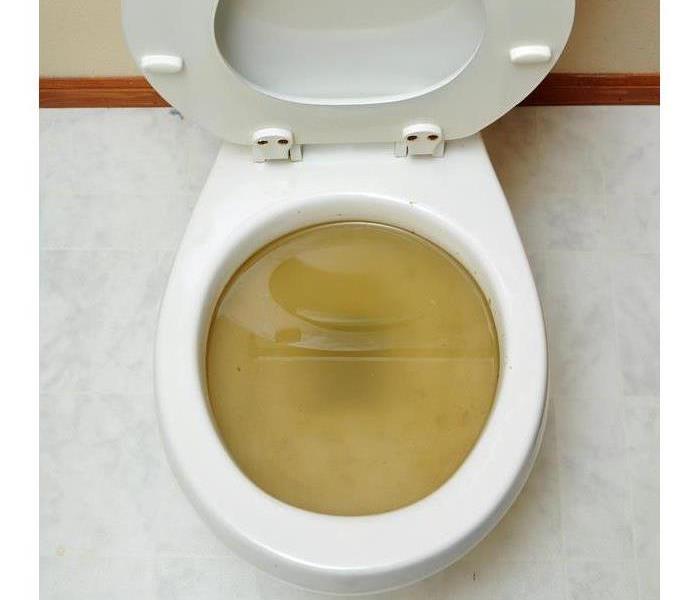 Toilet overflow in St. Peters, MO
Toilet overflow in St. Peters, MO
Take The Following Actions After a Toilet Overflow
With the simple push of a handle, toilet water should go down the drain, exiting quickly through the pipes. Sometimes, however, clogs occur, forcing the fluid to spill out of the commode and leading to sewer damage. Homeowners in St. Peters, MO, may think very little of the situation at first, grabbing for a plunger, cleaner and a mop; however, more may be needed to keep the rooms sanitary for future use. When the overflows happen, residents should take the following actions.
1. Stop the Flow
Focus on minimizing effects. At times, the spill just continues with moisture moving into walls and floors. Search for the shut off the valves in the restroom and outside. In addition, ensure that household members refrain from using washing machines, showers and dishwashers. This is a good time to call in a sewage company who can inspect the premises and determine a plan of action.
2. Address the Problem's Source
Discharges can happen for several reasons, so finding the obstacle should be the next step. At times, items have become lodged within the lines, preventing flow. Run a snake down the lines, forcing anything to push through. This may clear the path. Other times, breaks or hole may occur in the metal. Without a means of escape, the backup sends everything out from the closet exit point. If you're having trouble locating the sewer damage a water restoration company could run a camera through the system.
3. Clean Up the Flooding
Humidity and wetness pose several structural concerns. First, these conditions encourage mold to breed, increasing the likelihood of infestation. Second, the dampness could warp and ruin materials, weakening their integrity; therefore, the entire area, not just the flooded toilet, should be disinfected. Dry out the location; remove soaked contents and sterilize the space.
Lingering sewer damage is harmful to a house. Work swiftly to hinder water streams and correct the cause.
The 5 Steps of Water Mitigation
9/1/2020 (Permalink)
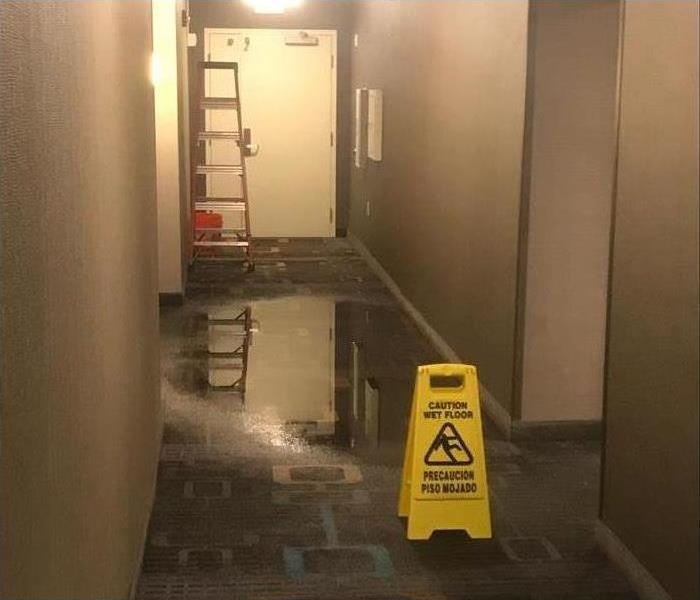 Standing water in an O'Fallon, MO office building
Standing water in an O'Fallon, MO office building
5 Mitigation Steps
Business owners often have a long daily to-do list to keep operations running smoothly. When a major water problem rears its ugly head, such as a supply line leaking, dealing with pipe burst cleanup isn’t something anyone wants to add to that list. While the initial discovery of water is unsettling, after finding and stopping the source, leaving the mess to a water damage and restoration specialist makes the process smooth and worry-free. Below are the mitigation steps you can expect as part of getting your business back to “Like it never even happened.”
1. Inspecting
To determine the type of water cleanup needed, a certified technician will complete a thorough inspection and assessment. That will include locating any hidden damage. They will define the damage.
2. Removing Water
Getting standing water and excess moisture out fast is key to preventing secondary issues. Professionals use the latest technologies and special equipment to make that happen.
3. Drying Out
A pipe burst cleanup often means hundreds of gallons of unwanted water. Even after the standing water is removed, there can be extreme saturation. Although the drying process may take weeks depending on the damage, the use of industrial fans and dehumidifiers make the process much smoother and faster than doing it alone.
4. Cleaning
The prevention of mold is a top concern. Cleaning all surfaces, flooring, carpeting, drapery and anything touched by water needs to happen. A professional has an array of cleaning methods to handle everything from wood floors to documents. They also have the tools to eradicate lingering odors.
5. Restoring
Although this may be the most complex part, the restoration process may mean different things for different situations. There is a likelihood that drywall and insulation will need to be replaced. Wood flooring severely damaged may also need repairs.
Instead of trying to tackle the massive task of pipe burst cleanup after damage to your O'Fallon, MO, business, leave every step of the process to trusted experts.
Preparing for the Insurance Adjuster's Visit
5/27/2020 (Permalink)
 A home adjuster is an important part of the insurance claims process
A home adjuster is an important part of the insurance claims process
To Prepare For The Adjusters Arrival, Follow These Steps
You have probably heard that floods are not included in a typical homeowners' policy. Yet many other types of water damage are covered. For instance, if water enters your home through a hole in the roof caused by a storm, you can file an insurance claim to pay for the cost of repairs.
Before your claim is finalized, a home adjuster will visit your property to see how much damage there is. To prepare for the adjuster's arrival, follow the below steps.
1. Make an Inventory
If it is safe to do so, walk around your home to see which items were damaged. Make a list of these possessions that includes costs and dates of purchase. You can give this list to the adjuster when he or she arrives.
2. Check for Structural Damage
The adjuster will also want to look at structural issues on your property. This includes any harm that occurred to the shed or swimming pool. Identify this damage in advance so you can show it to the adjuster.
3. Get Electrical System Inspected
Find out if the house has any electrical problems before the home adjuster arrives. The insurance provider may even cover the cost of this inspection.
Subsequent Visits
Keep in mind that if there is a major disaster in St. Charles, MO, the adjuster may have to visit numerous homes in your area within a short amount of time. As a result, the adjuster may initially only be able to provide an estimate of the damage. You can always set up a second appointment for a more thorough assessment.
Next Steps
After the adjuster has left, you can contact emergency restoration professionals. Your adjuster may even recommend a local company that he or she has worked with in the past. Make sure the adjuster has approved the cost of the cleanup before the work begins.
A home adjuster is an important part of the insurance claims process. If you properly prepare for his or her visit, you should get your money more quickly.
Benefits of Using a Certified Water Damage Expert
5/12/2020 (Permalink)
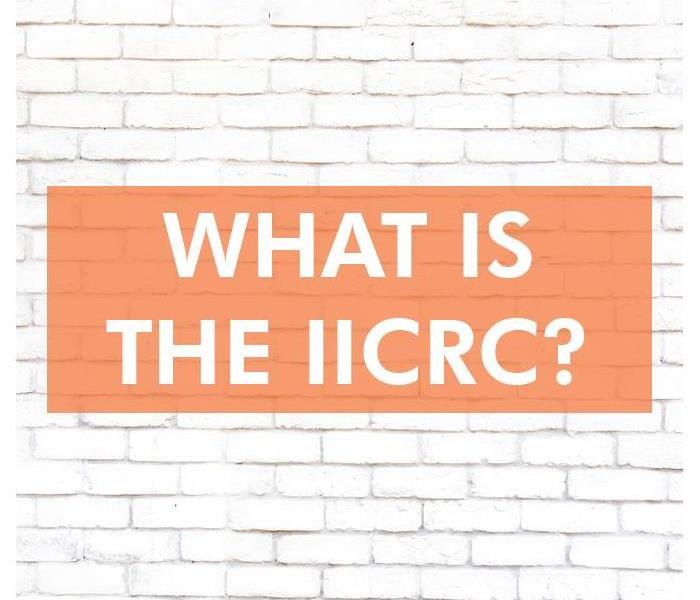 What is the IICRC certification?
What is the IICRC certification?
Water damage to your commercial property from such things as flooding or a broken pipe should always be taken seriously. If left untreated, the damage can pose serious health risks to your employees in Weldon Spring, MO. It is important to call a certified expert as soon as possible after the trouble occurs to assess the situation and handle the water clean up. When searching for a qualified company, make sure it employs IICRC-certified professionals.
What Is IICRC Certification?
The Institute of Inspection Cleaning and Restoration Certification (IICRC) is an organization that sets the industry standards and certification for cleaning, restoration, and inspection. A company has to pass a rigorous audit before obtaining certification. Each technician must also pass a strenuous written exam to ensure they are knowledgeable in their specific field.
What Are the Benefits of IICRC Certification?
Each individual that is certified by IICRC has been trained to handle water clean up in a safe and professional manner. Some of the benefits in choosing a certified professional include:
Works well under pressure - Certified technicians are trained to handle stressful emergencies with a level head. They are also excellent problem solvers.
Has specific knowledge to handle technical equipment - Trained professionals can safely and effectively operate all of the advanced drying, cleaning, and deodorizing equipment.
Can communicate well - A professional will be able to answer your questions with clear and concise responses so that you aren’t left in the dark.
Has the ability to handle large projects - A certified water restoration professional is trained to identify all problem areas and handle the water damage repair, especially on large commercial properties.
As you begin your search for a restoration company to take care of your water clean up, make sure you select an IICRC-certified company. This will give you the confidence you need to know that your property is in good hands.
How to Handle Leaks in Light Fixtures
2/14/2020 (Permalink)
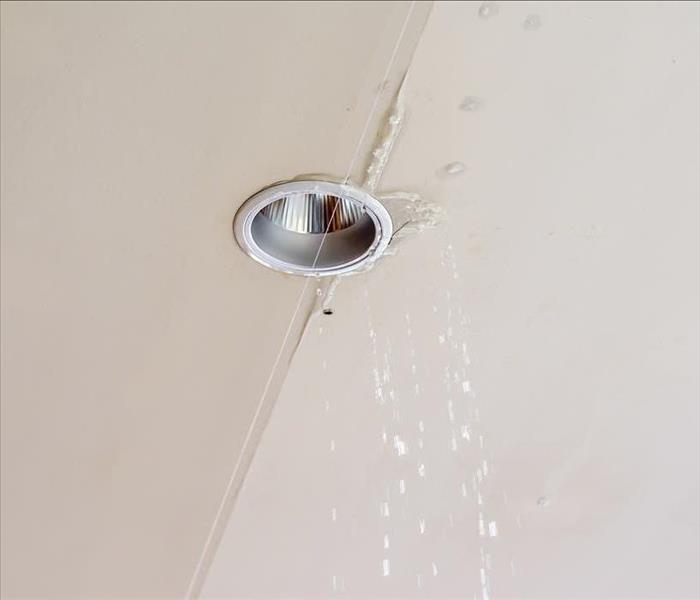 A "water in light" situation is the worst thing that could happen in the event of a leak
A "water in light" situation is the worst thing that could happen in the event of a leak
Possible Causes Of Water In Light Fixture
As a homeowner in St. Peters, MO, a "water in light" situation is the worst thing that could happen in the event of a leak. The result is a highly hazardous situation that requires urgent professional attention. The last thing you want to do is test your DIY talents with this type of project.
Possible causes of water in light include:
- An overflowing AC drip pan
- A leaking bathroom directly above
- Broken fire sprinklers
Turn Off the Electricity
There's no doubt water and electricity don't mix. For that reason alone, turn off the power at the main switchboard immediately you notice water in the electrical fixtures. That will mitigate ceiling damage and give you time to inform everyone of the impending danger.
However, do not assume the power is off just because you flipped a switch. Water can be pretty unpredictable, and there's no telling when or if it will get into the switch box. Instead, use a non-contact voltage tester to make sure the electricity is off.
Shut Off Water Supply
Depending on the situation, the leak could be coming from a plumbing accident. If so, find the main valve and turn it counterclockwise to cut the water supply. That should stop further water damage, saving you thousands of dollars.
Call the Professionals
Next, have a plumber come on-site to asses the leak. They should fix it quickly and get the area ready for electrical work. After that, get an electrician to replace the light fixture.
Keep in mind that this restoration process may take a long time to complete as the experts have to make sure the entire electrical system is free of water.
That said, please do not attempt to fix the "water in light leak" – unless you have training and experience in dealing with flooded electrical systems. Things can head south in an instant, leaving you homeless or even worse.
What To Know About Frozen Pipes
1/31/2020 (Permalink)
 Cold temperatures can lead to freezing which in turn can cause water damage
Cold temperatures can lead to freezing which in turn can cause water damage
What To Know About Frozen Pipes
Many business owners in St. Charles, MO, find that water damage occurs after a pipe freeze. There are a few things business owners should know about their pipes and any cold weather they may experience in their area. If you think you may be at risk for frozen pipes there are a few things you should know
1. How Freezing Leads To Damage
When water freezes it expands. These means that any water in the pipes during cold weather can expand and bush against the walls creating stress points. Enough stress from within can lead cracks which in turn can create broken pipes. When the water thaws it can seep through any cracks and create a leak, or if the chink is large enough flood the area.
2. Winterizing May Help Prevent Freezing
One way to help prevent this type of water damage is to winterize the pipes. This process usually involves turning of any water to outdoor spigots, and draining the water to ensure these pipes are empty. Pipes in areas where there is no insulation from outside temperatures may require additional insulation.
3. Damage Should Be Quickly Fixed
In the even that a frozen pipe does lead to flooding, it’s best to have the damage repaired as quickly as possible. If left unattended water caused damage can seep further in and lead to issues such as mold, swollen wood, and even cracks in the foundation. Fortunately, a local damage restoration service can help with a water cleanup as well as any repairs that need to be made.
Cold temperatures can lead to freezing which in turn can cause water damage. Winterizing your business’s pipes can help prevent this problem, but if damage does occur a local restoration service may be able to help. Remember, if damage does occur, it’s best to have it taken care of as quickly as possible.
Water in Light Fixtures Requires Precaution
12/13/2019 (Permalink)
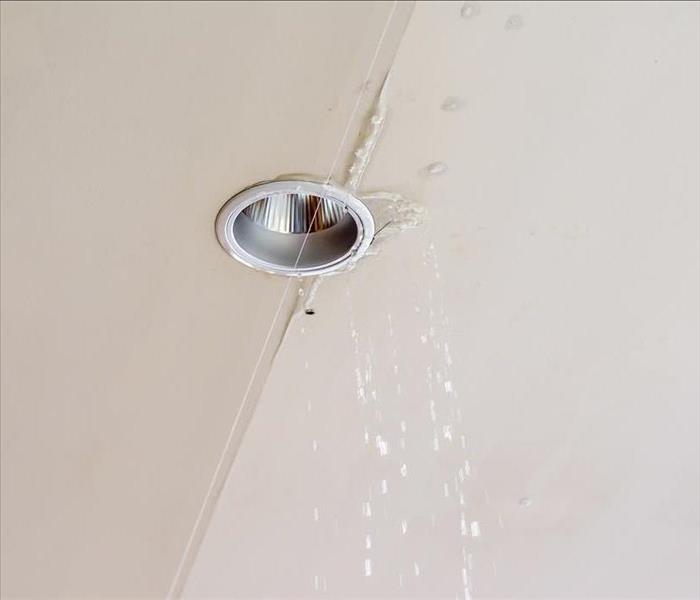 When there is water in light fixtures it becomes a more serious issue
When there is water in light fixtures it becomes a more serious issue
A water leak in your St. Peters,MO, is a hassle. When there is water in light fixtures, that hassle quickly becomes a more serious issue. Since water is an electrical conductor, a ceiling leak requires extra safety precautions. Although you may want to jump right in and solve the issue, staying safe needs to be the first priority.
4 Safety Precautions
At the first signs of water in a light fixture, take the following safety precautions to ensure no one is injured or a fire starts.
Immediately turn off the water and electricity in the home. This will stop extra water coming in if it is from a pipe burst and reduce the chances of an electrical fire starting.
Communicate the situation to everyone in the home. It is best to stay clear of any electrical sources until the situation is remedied. If possible, block access to the affected area.
Test that the electricity is off with a non-contact voltage tester. This includes checking outlets, switches, and appliances. Be sure to not touch sources with visible moisture.
Get professional help. A licensed electrician and water damage expert can help ensure the situation is safely handled and repaired.
Safe Cleanup
After finding water in light and taking the above precautions, you can begin to do some minor cleanup while you wait for the professionals. If water can still be visibly seen dripping, capture it with buckets or large bowls. Towels and newspapers can be used to absorb the standing water. Any rugs, furniture or other items that have been affected should be removed to dry out.
It's also important to find the source of the problem. Ceiling damage is often a result of a roof leak or plumbing issues. If there is a bathroom above the affected area, you will want to also call a plumber.
Water in light fixtures is not something to be taken lightly. By taking a few extra precautions, you can safely get the situation handled and your home back to normal.
3 Tips for Preventing Frozen Pipes
10/14/2019 (Permalink)
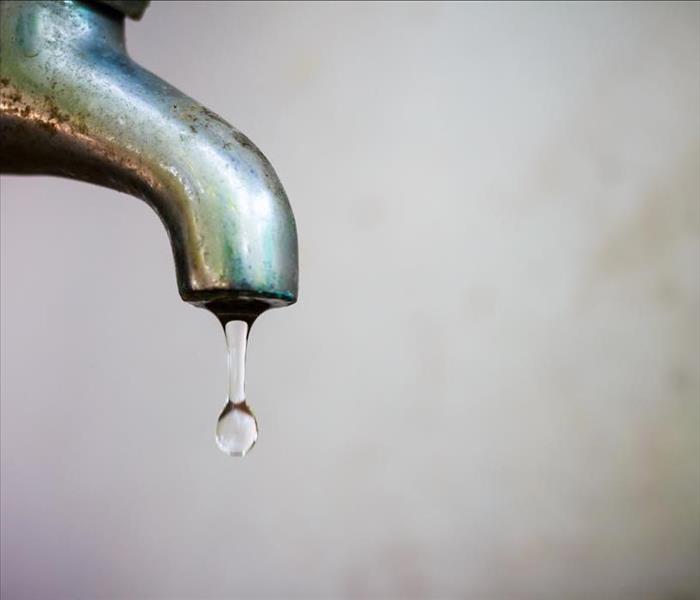 Let the faucet drip
Let the faucet drip
When it gets cold outside and you bundle up to stay warm, don't forget to give your pipes a bit of TLC. Dropping temperatures can lead to frozen pipes, causing them to burst and flood your St. Peters,MO, home. Too often, people who live in warmer climates don't take steps to protect their pipes. Remember that a pipe freeze can happen in any community when freezing temps cause an unusually cold day or two.
Metal Pipes Are the Main Risk
It's possible for pipes inside and outside the home to freeze. It's also possible that harm done during the winter may not show up until temperatures warm up again in the spring. Metal water pipes are particularly susceptible to the cold:
- Metal readily conducts cold from the water and the air
- Pipes tend to be only an inch or two in diameter
- Water systems run into the home from outside, carrying freezing temps inside
There are steps you can take to make sure the water running through your pipes doesn't freeze.
Leave the Heat On
If you plan to go out of town, leave the heat on. The ideal temperature is somewhere above 50 degrees Fahrenheit. If you generally turn your thermostat down at night, consider the same step of leaving it a bit higher when outside temperatures drop very low.
Let the Faucet Drip
When you open the faucet, water continues to move through the plumbing system, relieving pressure throughout the system. If you have hot and cold water in separate pipes, open both handles just a little bit.
Open Cabinet Doors
The pipes running under the sink can be kept a little warmer if you leave the cabinet doors open to allow access for the heated air of your home. Any rooms that you might otherwise close off should also be opened up to allow for warm air to pass through.
If you do experience frozen pipes, contact a St. Peters,MO, water damage remediation professional right away. Water causes damages quickly and freezing temperatures are sure to exacerbate the problem.
Prepare for a Visit From the Insurance Adjuster
8/29/2019 (Permalink)
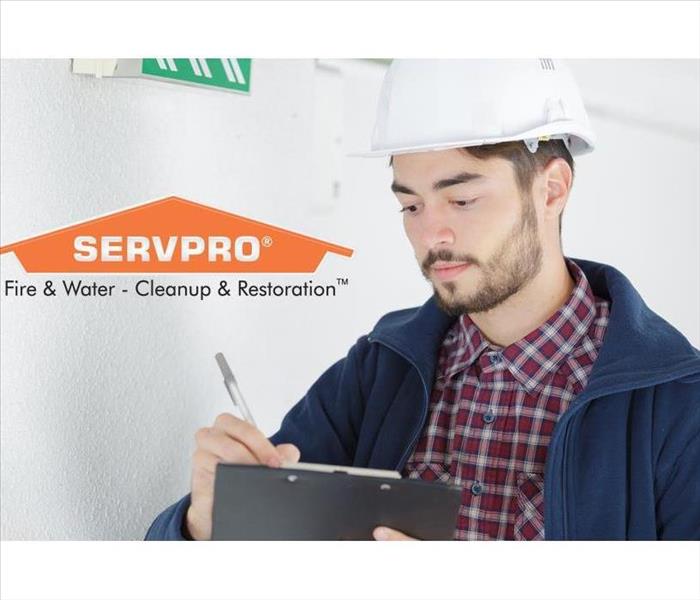 The insurance adjuster works closely with our team from start to finish
The insurance adjuster works closely with our team from start to finish
Filing a homeowner’s insurance claim in O'Fallon, MO, can be tricky if not handled correctly. Details are key in these situations, especially if the cause of the damage is not clear. To ensure your claim is accepted, you must know exactly what your policy requires you to do. If you skip some steps or miss any deadlines, the insurance agent may throw your claim out.
Contact Your Agent Immediately
Contact either your insurance agent or the insurance company to find out the specifics of your policy and what types of damage are covered. You will also need to know:
- How much time you have to file the claim
- If the claim will exceed your deductible
- How long the claim will take to process
- If they require repair estimates
Prevent Further Damage
Some insurance companies require that you do some temporary repairs or get board up services to secure the damaged areas and prevent further damage. You will want to save receipts for any purchases you make regarding the home damage, to collect insurance reimbursement. You should wait on completing large permanent repairs until the home adjuster assesses the damage.
Prepare a List
Before the home adjuster arrives, it is best to be prepared with a list of house damages as well as damaged belongings, so they can add this to their overall claim valuation. Your list should include the items, a description of each, approximate purchase date, and the replacement or repair cost. Having receipts for as many of these items as possible will help your case move more quickly.
If your insurance company requires bids from licensed contractors, collect a few written bids with materials and prices listed clearly. Keep copies of everything you provide to the home adjuster, as well as copies of paperwork they provide to you. Write down names and numbers of everyone at the company you speak with too, just in case something goes wrong with your claim.
Repair Your Home Back to Normal
Providing your home adjuster with as many details as possible will help to ensure your claim is accepted. Doing all of these things in an efficient manner is important too, as the longer some types of damages sit around, such as water damage, the more likely mold and further permanent damage can set in. Disaster remediation companies can help you repair both your home and damaged belongings quickly and thoroughly, saving you time and effort.
Three Crucial Steps in Removing Water From Your Flooded Basement
6/14/2019 (Permalink)
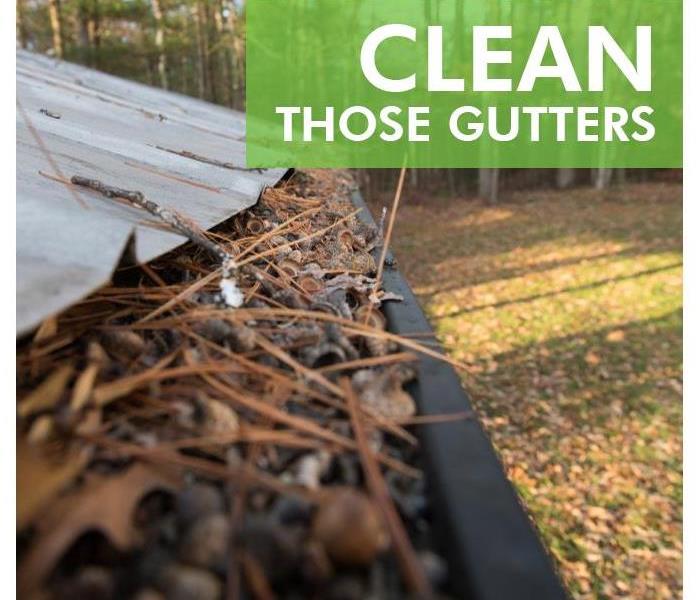 Cleaning your gutters can prevent future water problems in your home
Cleaning your gutters can prevent future water problems in your home
How to Stay Safe While Removing Water from Your Flooded Basement
Anyone that owns a home with a basement knows the fear the very thought of a foot of standing water reaching across the floor below ground can send up the spine. A basement flood is more than a nuisance; it can be a costly destructive force that destroys Christmas decorations, stored antiques, and even precious pictures and journals. The flood water can also seep into the structure of your home and weaken the foundation. No matter how the water got into your basement, you need to remove it as quickly as possible; however, to stay safe while doing so, there are three crucial steps to follow.
Stay out of the water.
The flooded basement can be an electrocution hazard, so stay out of the water. Call in a water removal and restoration team to get the liquid safely out as quickly as possible and while you are waiting for the team’s arrival, turn off the utilities to the area. If you must enter the water, wear rubber boots at least six inches higher than the water’s level and move very carefully with each step.
Know what to throw away.
Floodwaters are often filled with bacteria, fecal matter, and other chemicals that can damage your home and any items soaked by the liquid. Electronics, appliances, stored porous items, and water-soaked walls and floors resulting from a basement flood are probably damaged beyond repair. Make sure to itemize everything you throw away so you can apply for insurance coverage of each piece.
Prevent future water problems.
Floods are not always preventable. However, there are things you can do to help protect your home. Cleaning gutters, sealing foundation cracks, installing rubber water barriers, and sloping the ground around your house can help prevent future floods. Nothing is fool proof, but each of these steps can help.
A basement flood in Weldon Spring,MO, can be costly and cause serious damage to your home. When a flood does occur, use these three crucial steps when removing the water.
Safety First When Dealing With a Basement Flood
5/14/2019 (Permalink)
 Find out what type of insurance coverage you have and whether your insurance company has any requirements.
Find out what type of insurance coverage you have and whether your insurance company has any requirements.
Too many homeowners regularly deal with flooded basements after heavy rainfall and during the spring thaw. What can you do when this disaster strikes your own home? Take a look at the following steps for how to safely resolve a basement flood in St. Charles City, Illinois by addressing:
- Electricity
- Gas
- Insurance requirements
Avoid Electrocution
One of the first things you need to understand is that there's more than water damage to worry about. As soon as even an inch of water has collected in the basement, you need to address the danger of electrocution and the possibility of gas problems. If you have a service panel, a water heater, or other major appliances in the basement, there is a serious risk of electrocution. If the level of water is higher than the electrical outlets, do not go into the area. Instead, call the fire department for the safe removal of much of the water.
If the water level is low, begin by shutting off the power to the basement. If the breakers or circuits are in the basement, put down a wood or plastic step stool, so you don't touch the water. Keep all appliance cords out of the water and wear rubber boots while working in the flooded area.
Prevent Gas Leaks
Contact your gas company and get specific instructions from them for dealing with flooded gas appliances. There should be a gas shutoff on the outside of your home.
Contact the Insurance Company
Find out what type of insurance coverage you have and whether your insurance company has any requirements. For example, you may need to provide photographic proof of the flooding, or the insurance company may require you to work with specific flood remediation companies. Even if you intend to handle much of the work yourself, you need to know what your insurance company expects.
After making sure that electricity, gas, and insurance requirements have been satisfied, you can move forward with removing water and addressing damages caused by the basement flood. Remember you won't get much done if you, friends, or family members are injured before you even get started.
Preventing Water Damage During Building Construction
4/18/2019 (Permalink)
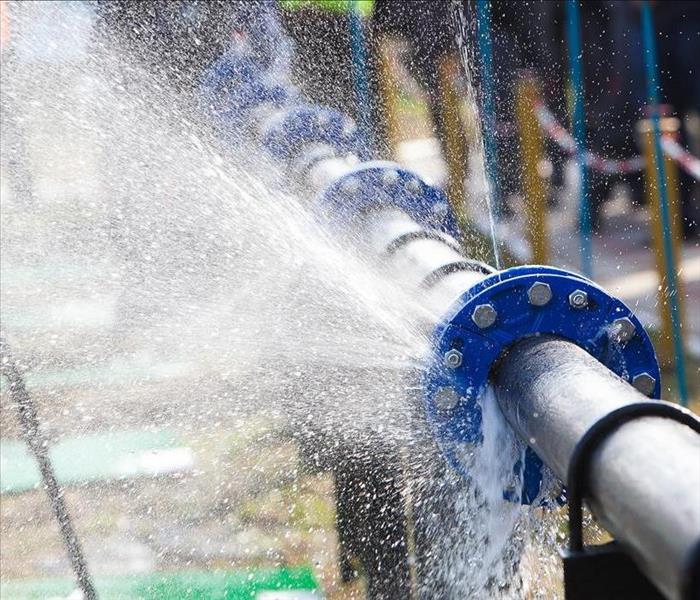 Broken pipe in a St. Peters, MO building
Broken pipe in a St. Peters, MO building
One of the most frequent losses caused during building construction is water damage. Whether it is the result of a flooding, unexpected rain storms, or a forgotten water pipe repair, the resulting water can cause delays in construction and an over-run on building material replacement costs. Here are three ways that water damage can cause problems.
Losses
Flooding from a broken pipe or a plumbing valve that was incorrectly installed can be one of the most frequent causes of water damage loss during construction. Losses can result in thousands of dollars due to
- Damaged material tear-out
- Removing debris
- Water remediation team expenses
- Material costs
- Employee wages
Reducing possible construction defects can help avert expensive repairs, as can taking precautions such as turning the water off at night to a building under construction. This can also help reduce your loss profitability.
Delays
Construction delays can result in a great deal of paperwork as insurance becomes involved. It may only be damage from a water pipe repair or sudden torrential rain storm, but when building materials are damaged, it can become costly, and contractors must turn to insurance as a partial remedy. Once water enters the building envelope, the losses in time and man-power can be staggering.
Reputation
In this social media rampant world, loss from water damage in a flooded area during construction can result in angry clients in St. Peters, MO, that may rant on one of their social walls about the building delays. That, in turn, can influence the way others look at you and your crew, and it may even prevent the possibility of future jobs.
Reducing water damage can be as simple as checking for water pipe repair issues during construction. By avoiding flooding, you can often prevent schedule delays and increase your profits. If you do have water damage problems, contact a water remediation team immediately for help to alleviate secondary water damage.
Three Things You Should Know About Water Damage
3/17/2019 (Permalink)
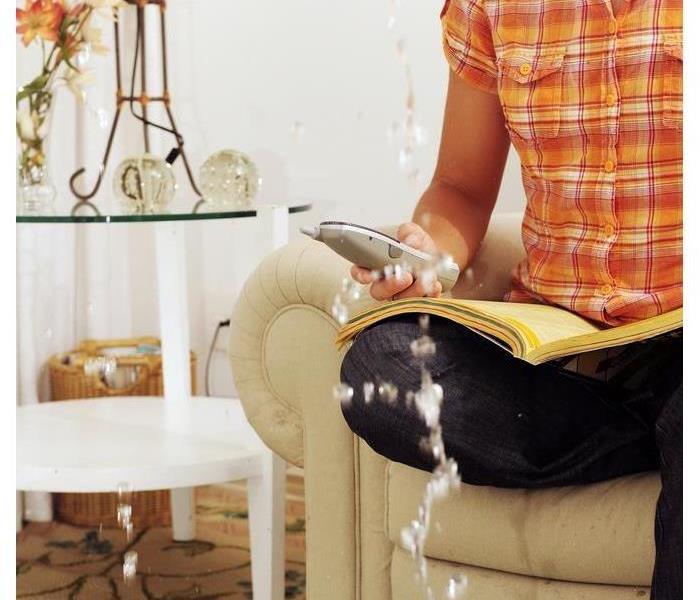 Leaking roof in a Weldon Spring, MO home
Leaking roof in a Weldon Spring, MO home
3 Things to Keep in Mind in The Event of Water Damage
Water from a storm or pipe burst is often the cause of home damage, but it is likely that you don’t know all there is to know about this common problem. Here are a few things to keep in mind in the event of water damage to your Weldon Spring,MO home.
1. It Can Come From a Variety of Sources
There are many things that can cause water damage. In the winter, frozen pipes can break, and snow or ice can cause damage to your roof and create a leak. A broken water line can also cause quite a bit of damage. Water can also come from a smaller source, such as a leaky pipe or cracks in the walls.
2. It Is Not Always Covered By Homeowners Insurance
Depending on the source of the water damage, you will not always be covered by your insurance. One example is if you have failed to maintain your home properly and a broken pipe or appliance is found to be caused by negligence. Another instance when you will generally not be covered is if the damage is caused by flooding. Most homeowners policies do not cover this type of natural disaster, and you will need to have a separate flood policy.
3. It Can Cause Significant Damage
Even if the source of damage seems insignificant, you should have it dealt with right away. A leaky window may not be as much of an emergency as having a pipe burst, but if it is ignored, the water damage will only worsen. Water can cause building materials to warp and can contribute to the growth of mold inside of your walls and flooring, so it should be taken care of as soon as you notice it.
Whether a pipe burst or a leaky roof has let in moisture, a professional water damage remediation service can help. They can repair both the source of water in your home as well as the resulting damage. If you notice water in your home, do not hesitate to get it fixed.
Prevent Water Damage While You Are Away
1/19/2019 (Permalink)
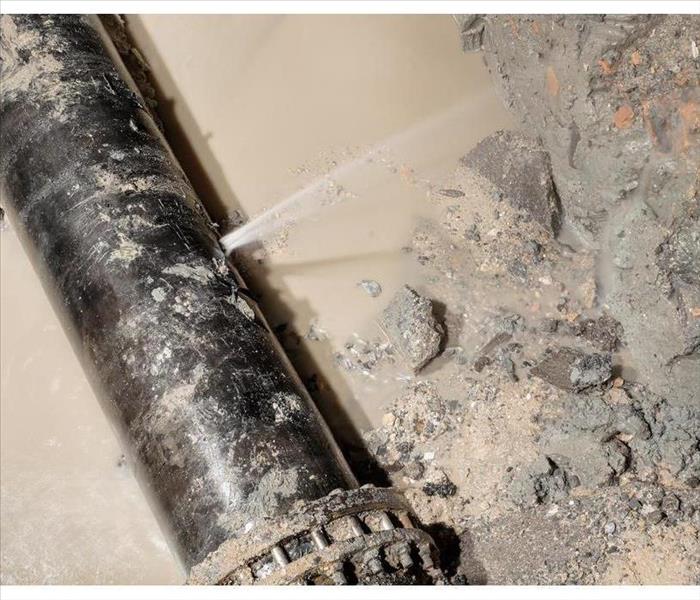 Broken pipe in St. Peters, MO
Broken pipe in St. Peters, MO
Have you ever traveled for an extended period of time and wondered what was going on in your home in St. Peters,MO? In order to prevent the necessity of water pipe repair, it is important to properly monitor your home while you are away.
Steps To Prevent Water Damage
In order to prevent water damage from a broken pipe while away from your home, here is a list of things you can do to prevent coming home to a house that is flooded.
- Make sure that your heat is on to prevent pipes from freezing while you are away.
- Have someone check on your home while you are gone or utilize a digital home monitoring system that can be viewed using your smart devices.
- Check all the pipes in your water system and heating system before departing to make sure there are no cracks.
- Ensure that your heating system is working correctly, that all necessary repairs have taken place and that the oil tank is filled if your home is heated by oil.
- Look at the connections to your appliances to determine they are secure and there is no chance of a leak occurring.
It is important to take the necessary steps to prevent a leak and do your best to ensure that water pipe repair is not needed when you return home.
What if Water Damage Occurs?
Even with all the preventative measures, there is no guarantee that you will not come home to a broken pipe or some sort of water damage. If something has flooded while you were away, it is important to take the proper steps to dry your home and personal property. Shut off the main water valve if the leak has occurred in a pipe in order to prevent further damage. If the amount of water damage is severe, a professional water mitigation company can help to restore your home and prevent future issues.
Sitting water can be harmful to your health and home. Prevent it if you can, and don’t be afraid to ask for help with water pipe repair when it is necessary.
What Water Damage Can Do To Your Home or Business:
11/15/2018 (Permalink)
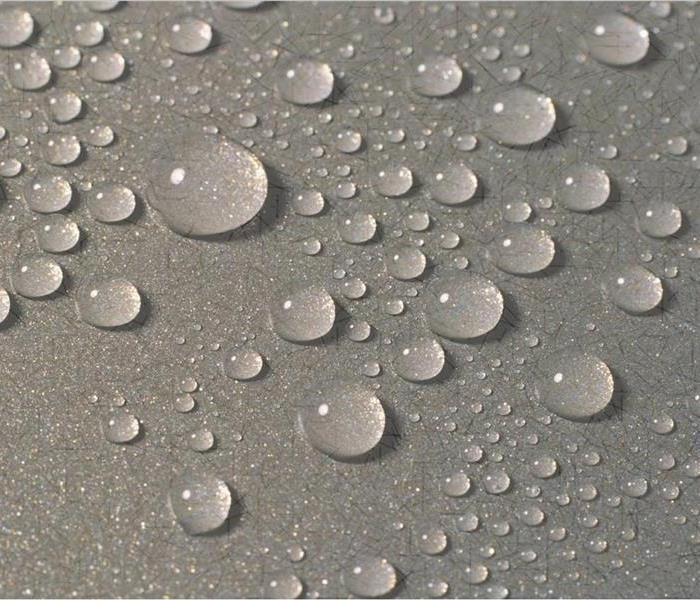 Common Water Damage
Common Water Damage
Flooding and water emergencies don’t wait for regular business hours and neither do we. SERVPRO of St Charles City and County provides emergency cleaning and restoration services 24 hours a day, 7 days a week—including all holidays.
Flooding and water damage is very invasive. Water quickly spreads throughout your home and gets absorbed into floors, walls, furniture, and more. SERVPRO of St Charles City and County arrives quickly and starts the water extraction process almost immediately. This immediate response helps to minimize the damage and the cleaning and restoration costs.
Need Emergency Service? Call Us 24/7 SERVPRO of St Charles City and County 636-926-0033
Here is a Typical Timeline for Water Damage:
Within Minutes:
- Water quickly spreads throughout your property, saturating everything in its path.
- Water is absorbed into walls, floors, upholstery, and belongings.
- Furniture finishes may bleed, causing permanent staining on carpets.
- Photographs, books, and other paper goods start to swell and warp.
Hours 1 - 24:
- Drywall begins to swell and break down.
- Metal surfaces begin to tarnish.
- Furniture begins to swell and crack.
- Dyes and inks from cloth and paper goods spread and stain.
- A musty odor appears.
48 Hours to 1 Week:
- Mold and mildew may grow and spread.
- Doors, windows, and studs swell and warp.
- Metal begins to rust and corrode.
- Furniture warps and shows signs of mold.
- Paint begins to blister.
- Wood flooring swells and warps.
- Serious biohazard contamination is possible.
More Than 1 Week:
- Restoration time and cost increase dramatically; replacing contaminated materials and structural rebuilding may be extensive.
- Structural safety, mold growth, and biohazard contaminants pose serious risks to occupants.
About SERVPRO of St Charles City and County
SERVPRO of St Charles City and County specializes in the cleanup and restoration of residential and commercial property after a fire, smoke or water damage event. Our staff is highly trained in property damage restoration. From initial and ongoing training at SERVPRO’s corporate training facility to regular IICRC-industry certification, rest assured our staff is equipped with the knowledge to restore your property.





 24/7 Emergency Service
24/7 Emergency Service
































